





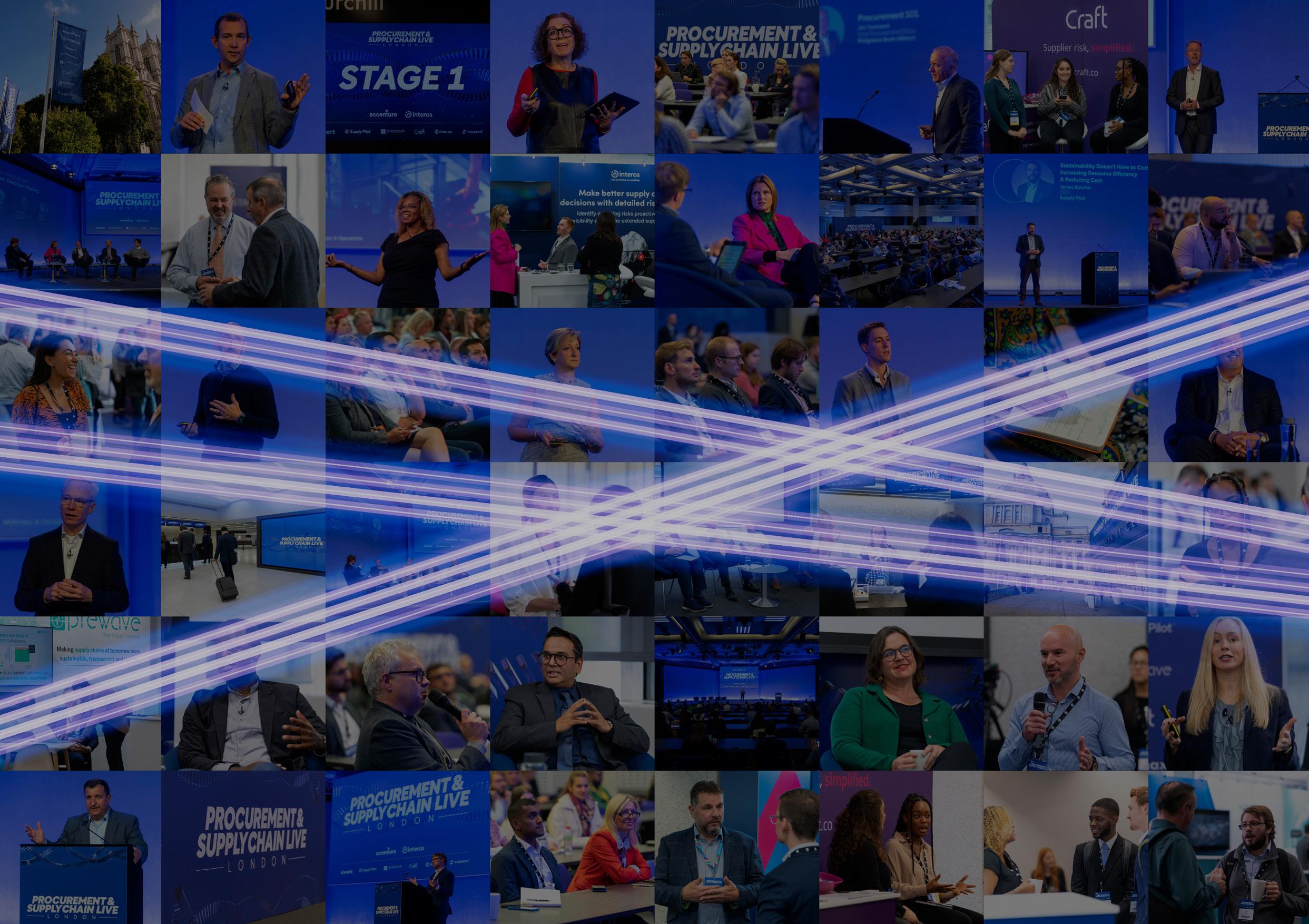
26 - 27 September 2023
Business Design Centre, London
SPONSORSHIPS GET YOUR PASS

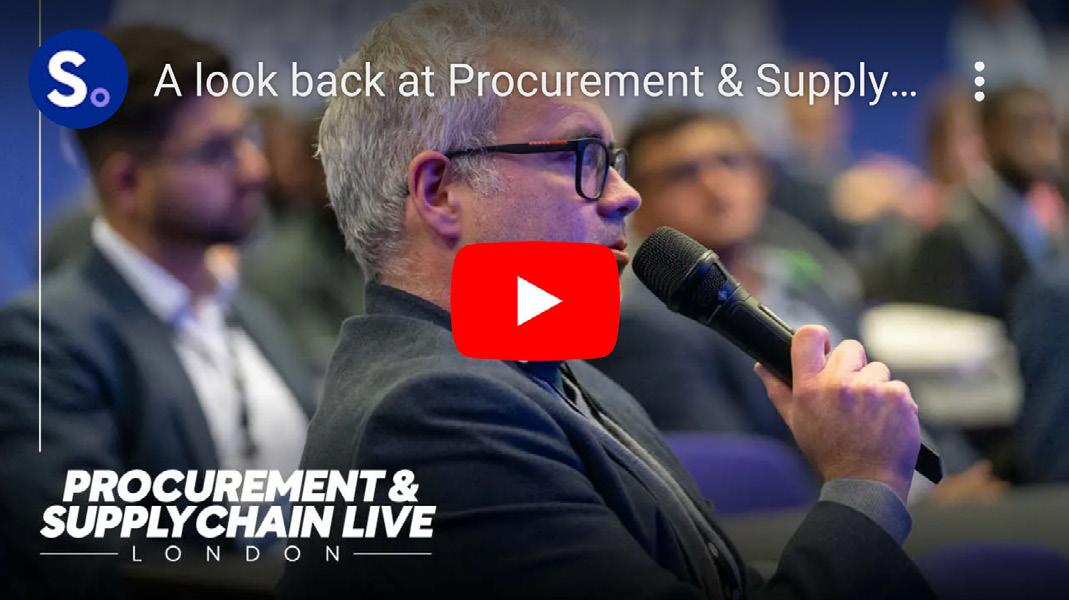
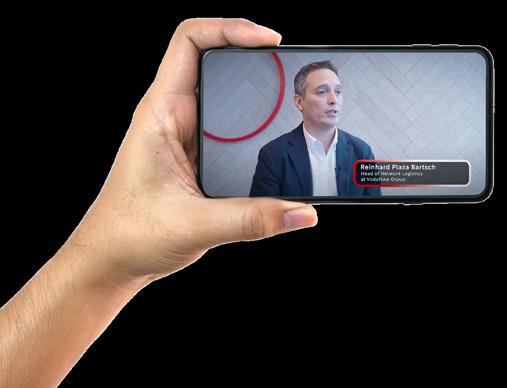
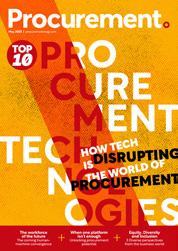
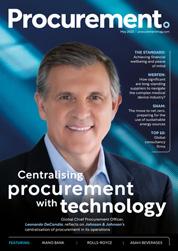
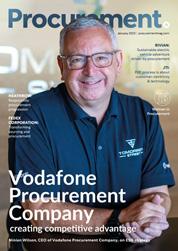
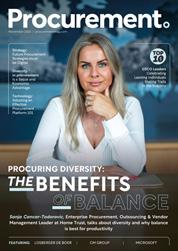
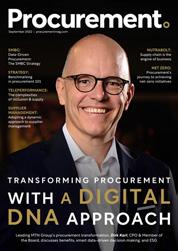

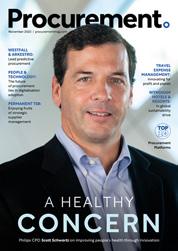
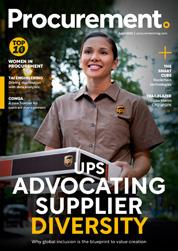


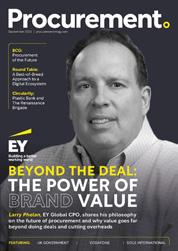
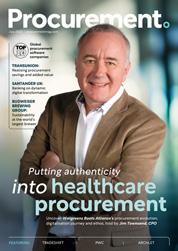
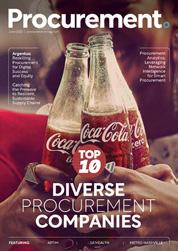





































Procurement magazine is an established and trusted voice with an engaged and highly targeted audience of 70,000 global executives
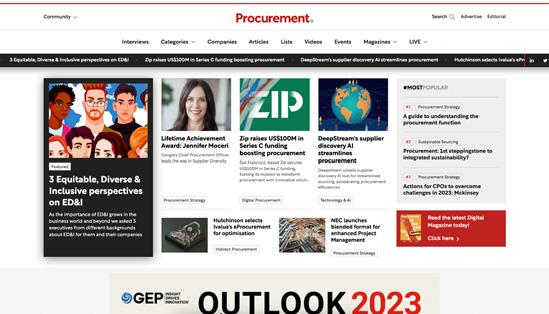






Digital Magazine

Website Newsletters
Industry Data & Demand Generation
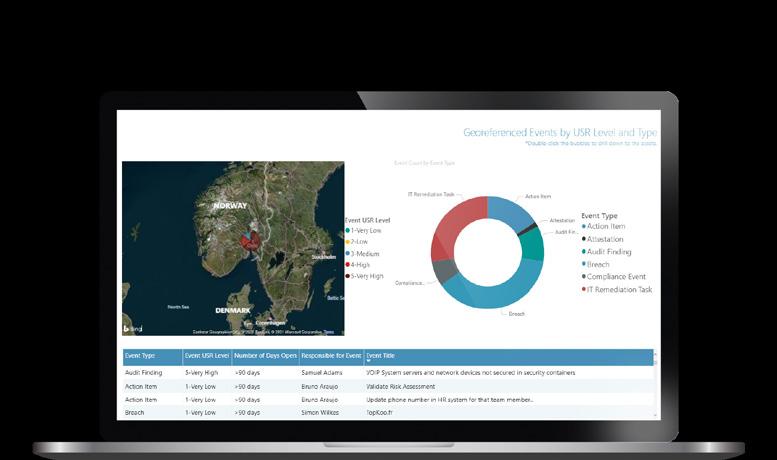
Webinars: Creation & Promotion
White Papers & Research Reports
Lists: Top 10s & Top 100s
Events: Virtual & In-Person



WORK WITH US

EDITOR-IN-CHIEF/ MANAGING EDITOR
NEIL PERRY
CHIEF CONTENT OFFICER
SCOTT BIRCH
CHIEF DESIGN OFFICER
MATT JOHNSON
HEAD OF DESIGN
ANDY WOOLLACOTT
LEAD DESIGNER
JULIA WAINWRIGHT

FEATURE DESIGNERS
MIMI GUNN
SOPHIE-ANN PINNELL
HECTOR PENROSE
SAM HUBBARD
REBEKAH BIRLESON
ADVERT DESIGNERS
JORDAN WOOD
DANILO CARDOSO
CALLUM HOOD
VIDEO PRODUCTION MANAGER
KIERAN WAITE
SENIOR VIDEOGRAPHER
HUDSON MELDRUM
DIGITAL VIDEO PRODUCERS
ERNEST DE NEVE
THOMAS EASTERFORD
DREW HARDMAN

SALLY MOUSTAFA
PRODUCTION DIRECTORS
GEORGIA ALLEN
DANIELA KIANICKOVÁ
PRODUCTION MANAGERS
JANE ARNETA
MARIA GONZALEZ
YEVHENIIA SUBBOTINA
MARKETING MANAGER
KATHRYN WEBB
PROJECT DIRECTOR
STUART IRVING
JAMES BERRY
MEDIA SALES DIRECTOR
JAMES WHITE
MANAGING DIRECTOR
LEWIS VAUGHAN
CEO
GLEN WHITE
Amid supply disruption and uncertainty, strategic procurement is vital. AI and ML automation solutions are transforming the profession, freeing up time for contract management and vendor lifecycle while addressing ESG, risk and performance needs
Ongoing supply disruption and the prevailing climate of economic and geopolitical uncertainty means there has never been a greater need for procurement to be a strategic business function. This, in turn, is driving the adoption of AI and machine learning (ML) solutions in automating the less strategic aspects of procurement –which, traditionally, have been something of a time-sink for the profession.

Procurement leaders are expected to drive the execution and management of contracts in collaboration with internal stakeholders and suppliers. Their teams, meanwhile, are also expected to contribute to the vendor management lifecycle, including areas such as ESG, risk, and performance requirements.
Today, there's a raft of procurement automation solutions to do the heavy lifting in these and other areas.
NEIL PERRY
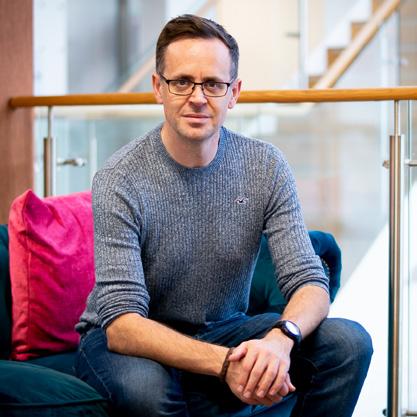
neil.perry@bizclikmedia.com

“The ability to automate decision making is a fast-growing trend that’s driving positive outcomes for supply chain functions”
014 BIG PICTURE
Large Language Models seeing swift and increasing adoption by procurement teams



016 INTERVIEW WITH...
Jennifer Jewson, Chief Procurement Officer for LyondellBasell

020 LIFETIME OF ACHIEVEMENT
MTN Group’s visionary
CPO Dirk Karl
016
020
014







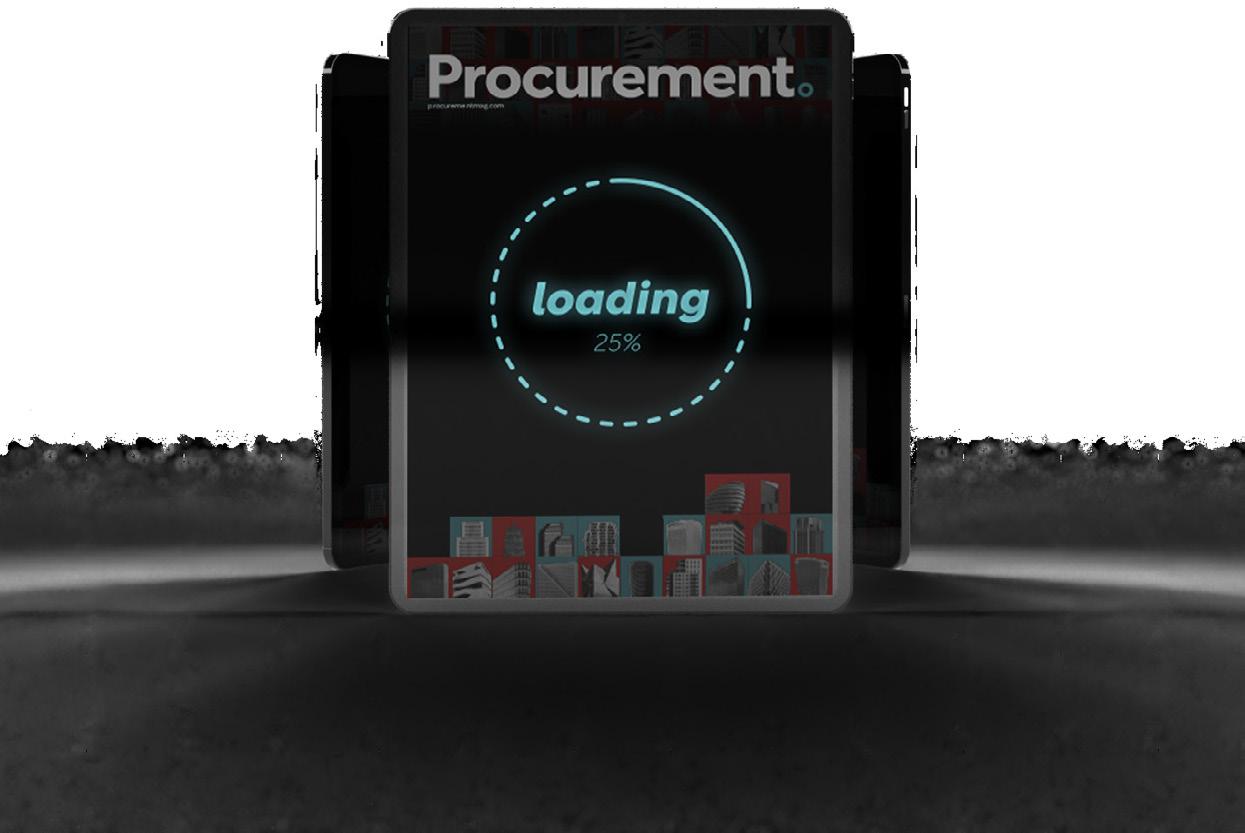






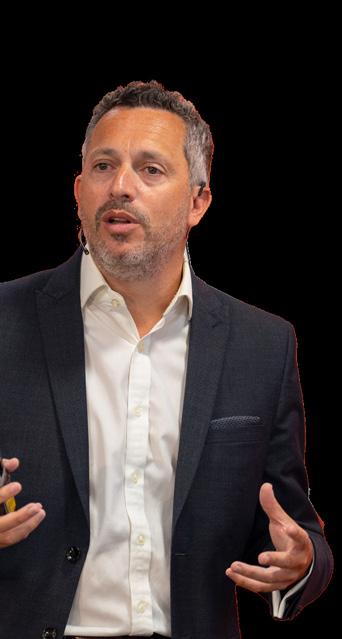
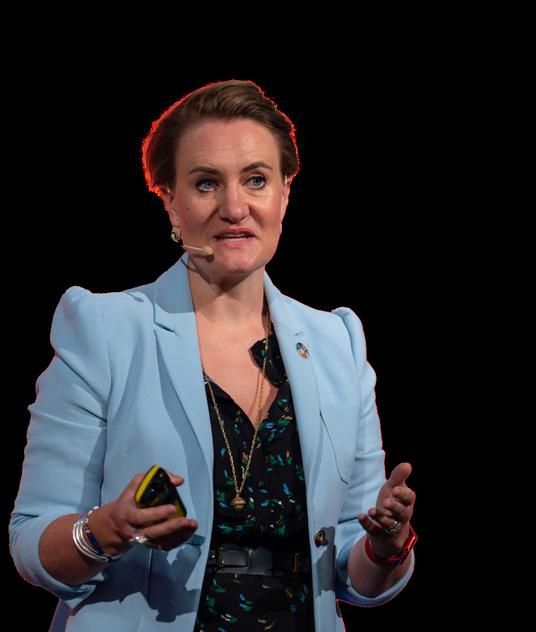
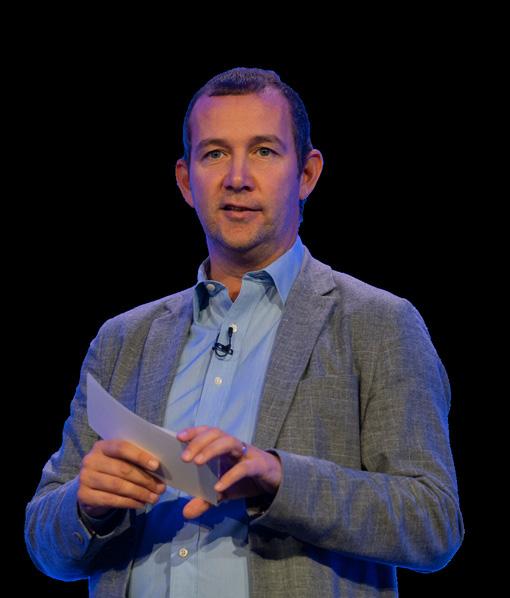

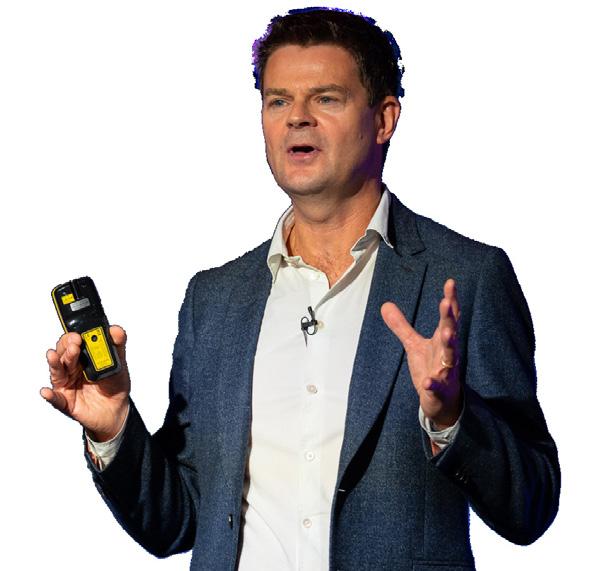












Large Language Models are gaining traction in procurement, offering benefits such as work process automation, cost reduction and informed decision-making.
While procurement teams initially hesitated due to concerns like high costs and data security, more organisations are embracing these models.
LLMs assist in several areas across procurement, including vendor selection, spend analysis and supplier relationship management. By leveraging AI’s efficiency, market insights, risk identification and cost-saving opportunities, procurement professionals can focus on strategic tasks. However, accuracy, security and the need for human judgement remain concerns. Combining AI and human intelligence allows for improved decision-making and fosters vital connections with stakeholders and suppliers.
Q. PLEASE COULD YOU START BY INTRODUCING YOURSELF AND YOUR ROLE?
» My name is Jennifer Jewson and I’m the Chief Procurement Officer for LyondellBasell. We are a leader in the global chemical industry creating solutions for everyday sustainable living. We produce chemicals, polymers and compounded products used in critical applications ranging from sustainable transportation and food safety to clean water and quality healthcare. Our Procurement team procures materials for both the direct and indirect categories and is located in the Americas, Europe and Asia.
Q. HOW DID YOU COME TO WORK IN THE PROCUREMENT INDUSTRY?

» I have worked for LyondellBasell for 25+ years and started as a Ph.D. chemist in the Research and Development team. I went back to school to earn a Master of Business Administration in Finance and then moved over to commercial roles running some of our businesses. I was asked to move from the sell-side

to the buy-side of the company as we wanted to have a greater connection from our suppliers to our customers.
Q. WHAT KEY TREND IN THE PROCUREMENT INDUSTRY ARE YOU FINDING MOST INTERESTING CURRENTLY?
» The movement to more sustainable raw materials. This trend is allowing for greater collaboration amongst suppliers, customers and peers within our industry. The work to recycle plastics either through mechanical or advanced recycling to make a pyrolysis oil feedstock is key for a more sustainable future. We are exploring other sustainably sourced materials such as additives for


“My greatest achievement has been the ability to drive change within our company through the relationships that I have built over my career”
The Wesseling, Germany, complex is LyondellBasell’s largest manufacturing facility in Europe
IMAGE: LYONDELLBASEL
some of our key products. This takes time and requires collaboration between suppliers and customers. We also strive for supplier diversity and to create an environment where people can bring their true selves to work.
» Take risks, you never know how much you can achieve unless you push yourself. Throughout my career, I have been asked to take roles that I may not have pursued otherwise and am glad that I took the challenge. I learned that I can adjust quickly and produce results. I was able to broaden my career and my viewpoint which has made me a greater asset for my company and a more strategic thinker.
» The ability to drive change within our company through the relationships that I have built over my career.
I have worked at LyondellBasell and predecessor companies for over 25 years. During that time I have been able to build a network of talented

individuals, which I have been able to lean on for projects or roles during my tenure.
Together, we have been able to make a major impact and have had fun along the way. I love to see talent grow and become future leaders for our company.
» Not getting in my own way when driving progress for our team. It is incredibly important to step back and empower your team to lead.
As I have gained more experience, I have been able to observe time and time
“This is a great time in our industry as we create more sustainable products for our customers”
again that the team will always come up with better ideas collectively than I would have been able to do on my own.
Diversity of thought is key to drive innovation, collaboration and overall performance.
» Continue positioning Global Procurement as a true business partner for our company as we drive value and sustainable solutions. This is a great time in our industry as we create more sustainable products for our customers.
We are looking at the end to end value chain to find those solutions that are better for our environment, the economy and society as a whole. We have the opportunity to truly make a difference, and I am able to collaborate more than ever with my peers, suppliers and customers.
 Q. PLANS FOR THE FUTURE?
25+ Years Jennifer Jewson has worked for LyondellBasell
Q. PLANS FOR THE FUTURE?
25+ Years Jennifer Jewson has worked for LyondellBasell

Boasting a remarkable career spanning over 25 years, Karl brings a wealth of expertise in strategic sourcing, supply chain management, and IT to his role. His professional experience encompasses various sectors, including telecommunications, automotive, and finance, and extends across diverse geographical regions.
Prior to joining MTN Group, Karl played a pivotal role as part of the founding team of BUYIN, a leading telecom procurement alliance established by Orange and Deutsche Telekom. His contributions at BUYIN were instrumental in shaping the organisation’s success.
TITLE: GROUP EXECUTIVE AND CHIEF PROCUREMENT OFFICER
COMPANY: MTN GROUP
Dirk Karl is Group Executive and Chief Procurement Officer (CPO) of Global Sourcing and Supply Chain at MTN Group, a highly regarded telecoms company.
He also serves as a valued Board Member of Global Sourcing Company. With comprehensive oversight over Sourcing andSupply Chain operations throughout the MTN Group, Karl is entrusted with managing an impressive annual spend of US$12bn across 19 countries, catering to the needs of over 280 million mobile subscribers.
Since his arrival at MTN in 2017, Karl has made significant contributions that have powered the company’s sourcing and supply chain management operations.
Through the implementation of multiple strategic initiatives, the sourcing business has witnessed remarkable growth, with EBITDA results increasing by more than 30%. Karl’s visionary leadership has propelled MTN’s sourcing and supply chain functions to the forefront of the industry.
One of the key drivers of this success has been Karl’s ambitious digitisation program, which leverages cutting-edge
technologies like artificial intelligence and machine learning. A notable achievement is the in-house developed “Nerve Centre,” a groundbreaking platform that harnesses the power of big data to unlock valuable insights and drive fact-based decision-making.
Recognising the need for innovation, impact and agility, Karl spearheaded an operating model transformation within the MTN Group. This transformative endeavour embraced agile methodologies and tapped into a strategic talent pool of sourcing experts, supporting the company’s aspirations to evolve from a telecommunications provider to a technology-driven entity.


Karl’s remarkable contributions have garnered industry-wide recognition. He has been prominently featured in esteemed publications such as Forbes Middle East as one of the Top Regional Executives.
Under his leadership, the Global Sourcing and Supply Chain organisation at MTN Group was honouredwith the prestigious “Best Use of Digital Technology” accolade at the CIPS Middle East Procurement Awards.
Most recently, Karl received the esteemed “Lifetime Achievement Award” at the 4th Africa Procurement and Supply Chain Awards, a testament to his outstanding accomplishments
throughout his career. In summary, Karl’s tenure as Group Executive and CPO of Global Sourcing and Supply Chain at MTN Group has been marked by remarkable achievements and transformative initiatives.
His extensive industry experience, strategic vision, and relentless pursuit of innovation have not only propelled MTN Group’s sourcing and supply chain functions to new heights but have also garnered widespread recognition within the industry.
Karl’s outstanding leadership continues to shape the future of MTN Group and the telecommunications sector as a whole.


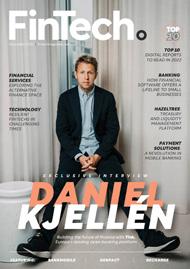
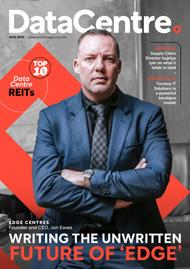











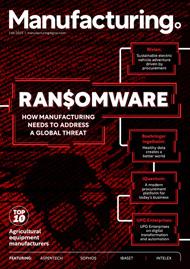







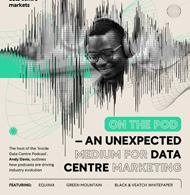
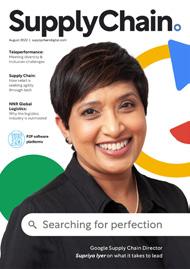

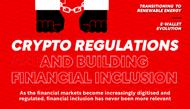






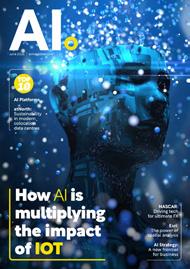












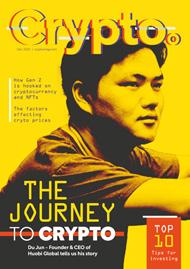



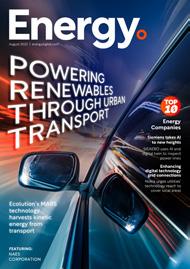









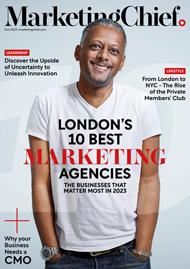

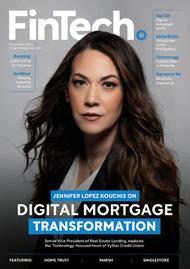

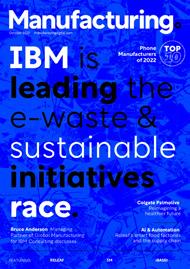
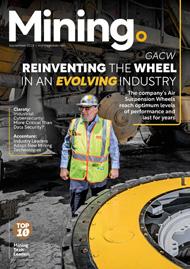

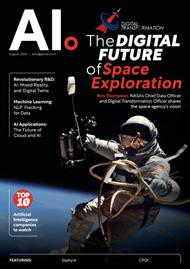








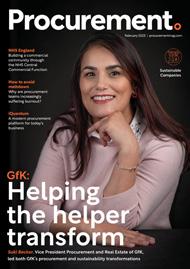

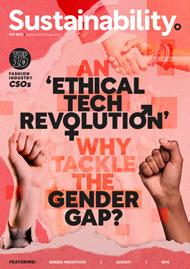

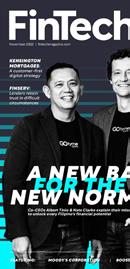
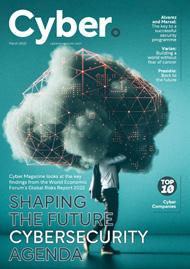
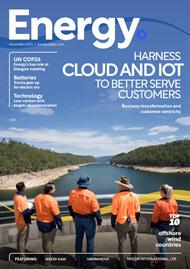

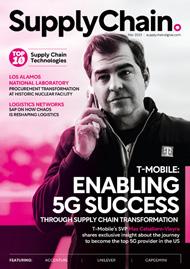



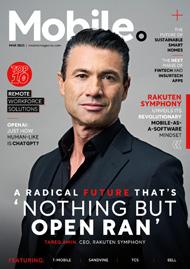
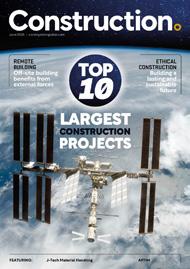


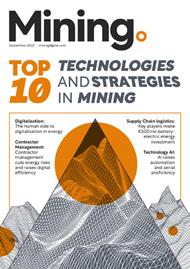



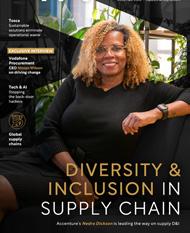














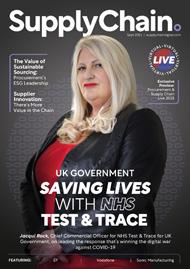






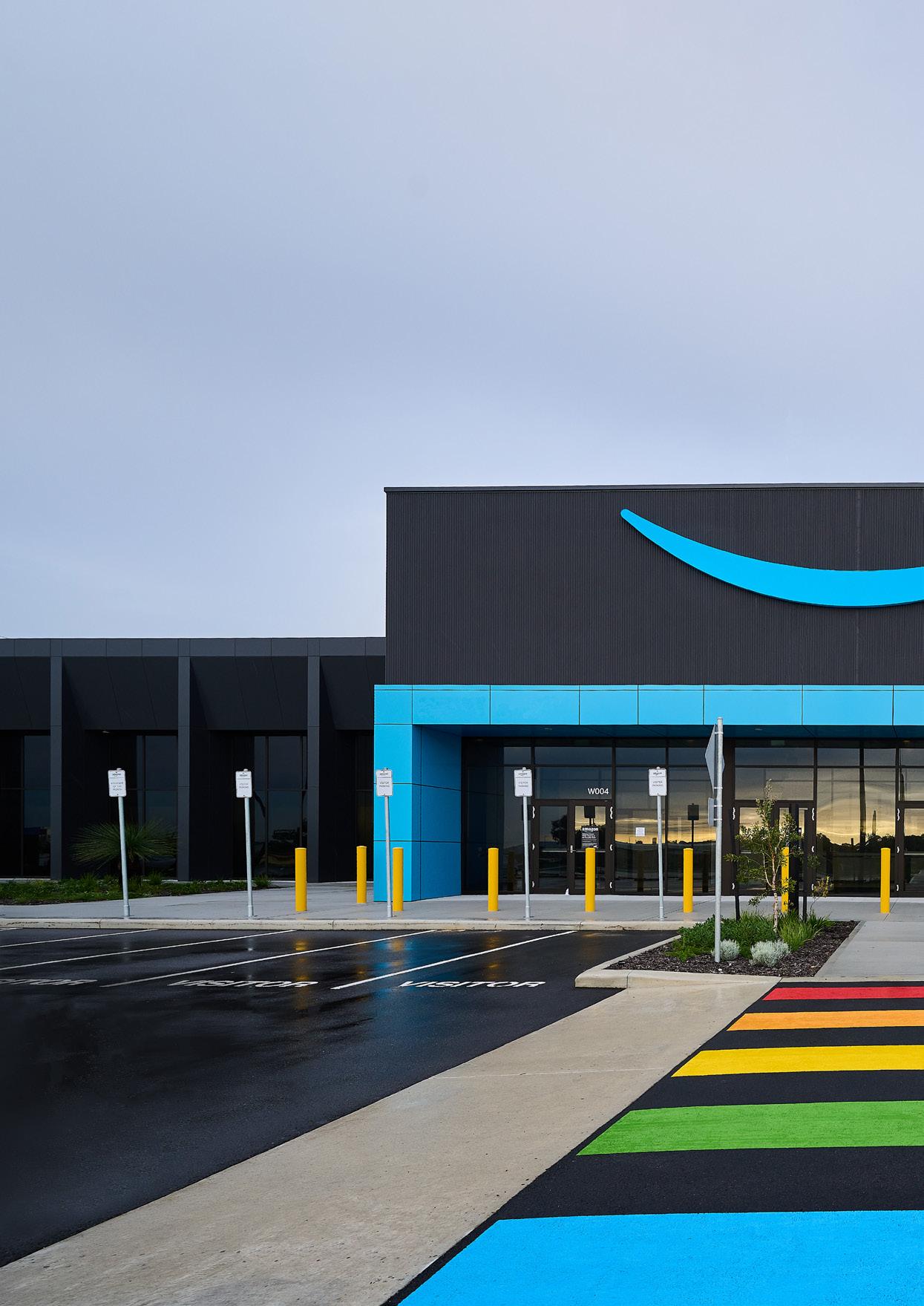 WRITTEN BY:
LUCY BUCHHOLZ
STUART IRVING
WRITTEN BY:
LUCY BUCHHOLZ
STUART IRVING
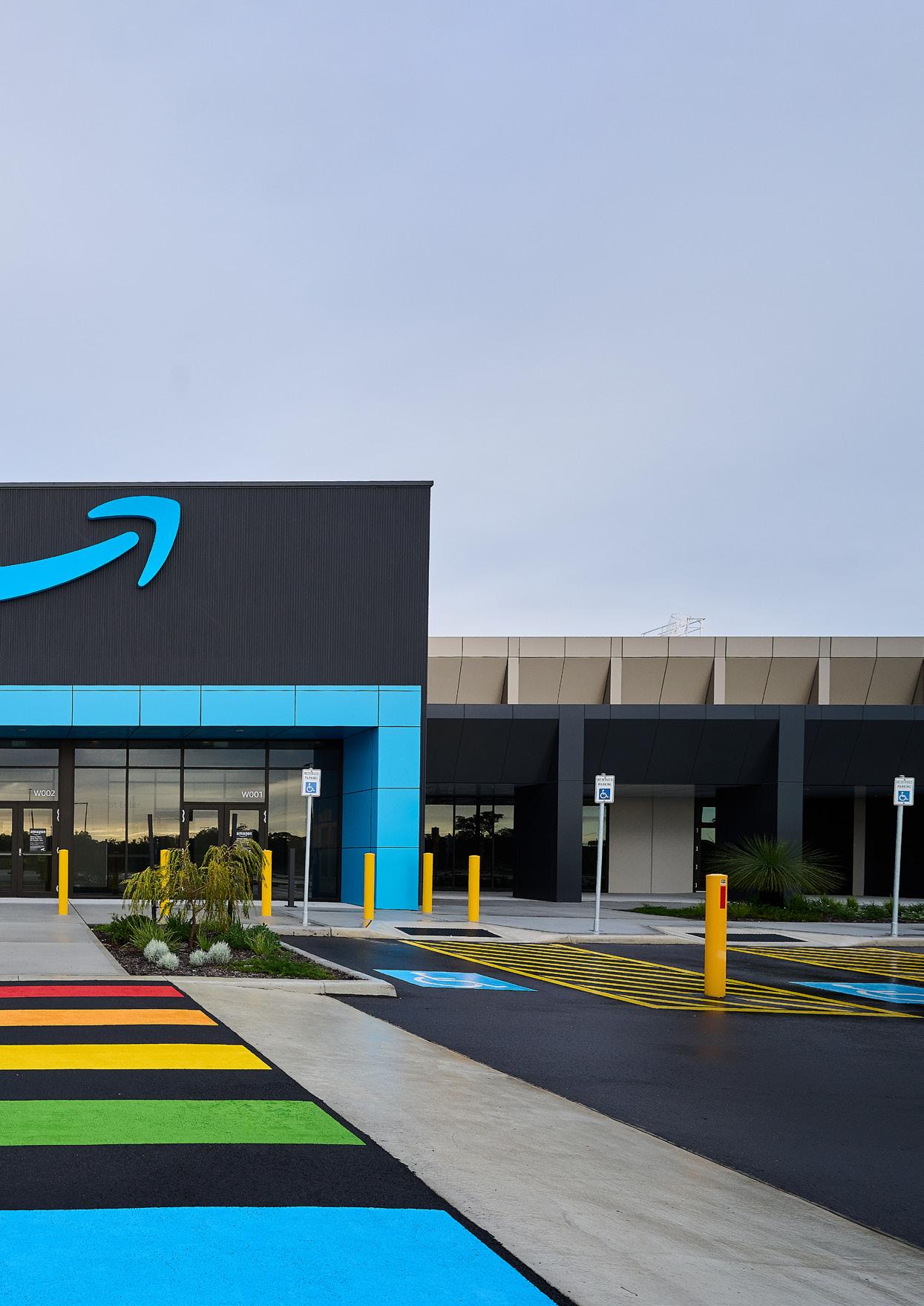
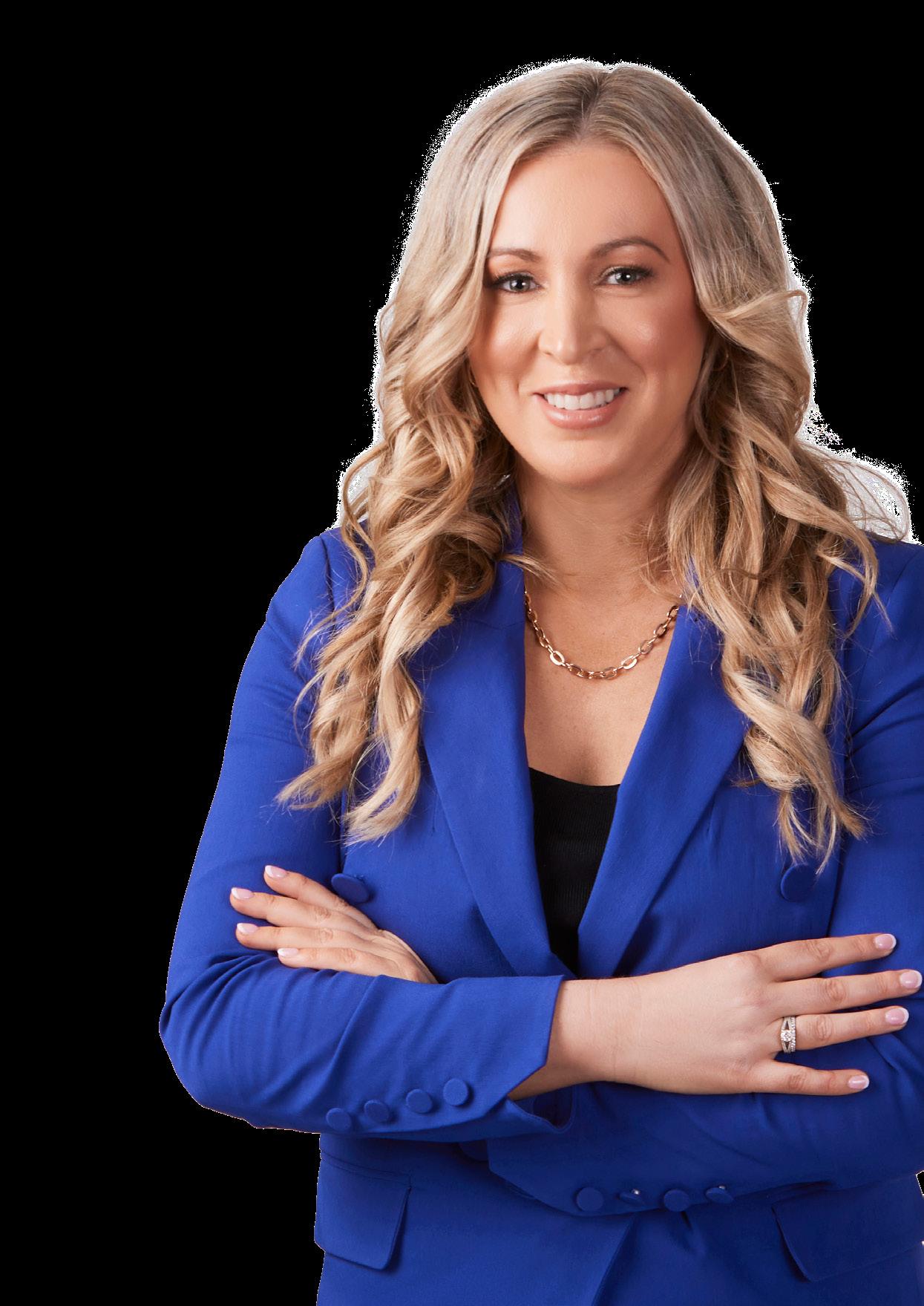
Use more image captions as often as possible

As Australia is a vast country, with its major cities located hundreds of kilometres away from one another, Amazon has been focused on offering great value, increasing its selection of products and improving delivery speeds. This has been made possible as a result of Amazon’s continued investment and expansion of its operations in Australia, including doubling its operational capacity in 2022 with the opening of its first robotics fulfilment centre in Kemps Creek, Sydney.
Each year, Amazon prepares for two major events – Prime Day and Black Friday, which kick off the holiday season and are the busiest periods of the year.
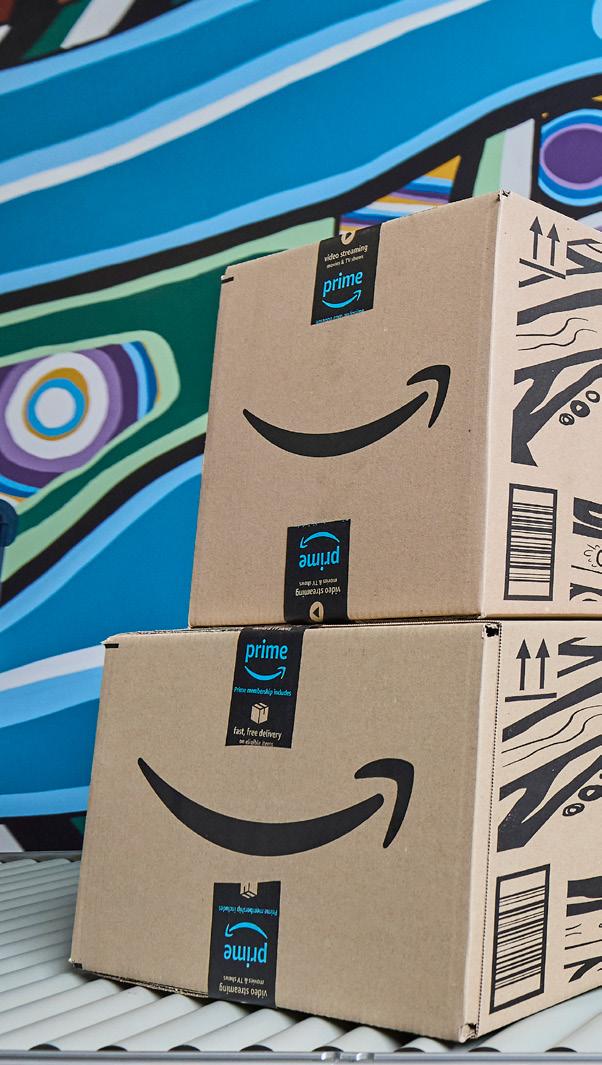
“Amazon experiences its biggest customer demand during these events,” Godschalx explains,
“so the entire company is busy preparing. This includes demand planning with our suppliers and increasing our inventory, non-inventory and our labour force.”
What’s more, Amazon Australia employs more than 7,000 people across a variety of different sectors, spanning amazon.com.au, Amazon Web Services (AWS), Kindle, Alexa and Prime Video.
As one of the most remote cities in the world, Perth – on Australia’s west coast –is located far from Australia’s other fulfilment centres on the east coast, Amazon is opening a new fulfilment centre in the city later this year to increase its Western Australian presence by 60%, bringing more inventory closer to customers.
“By opening a new fulfilment centre in the city, our customers in Perth will be able to access an even greater selection of items
 Amazon Robotics Fulfilment Centre in Kemps Creek, Sydney
Amazon Robotics Fulfilment Centre in Kemps Creek, Sydney
By opening a new
that can be shipped quickly,” Godschalx says. “This will be a huge win for the region.
“Aside from that, my team has been busy focusing on delivering our portfolio pipeline of plans for the business. We’re focused on making sure customers get what they want, when they need it.”
For Godschalx, this is one of the key areas in which she focuses her procurement efforts. She explains that it’s imperative for the company to have strong relationships with suppliers to ensure Amazon remains flexible and dynamic.
“To do so, we ensure we are increasing our relationships and focus on partnering with suppliers that meet our expectations
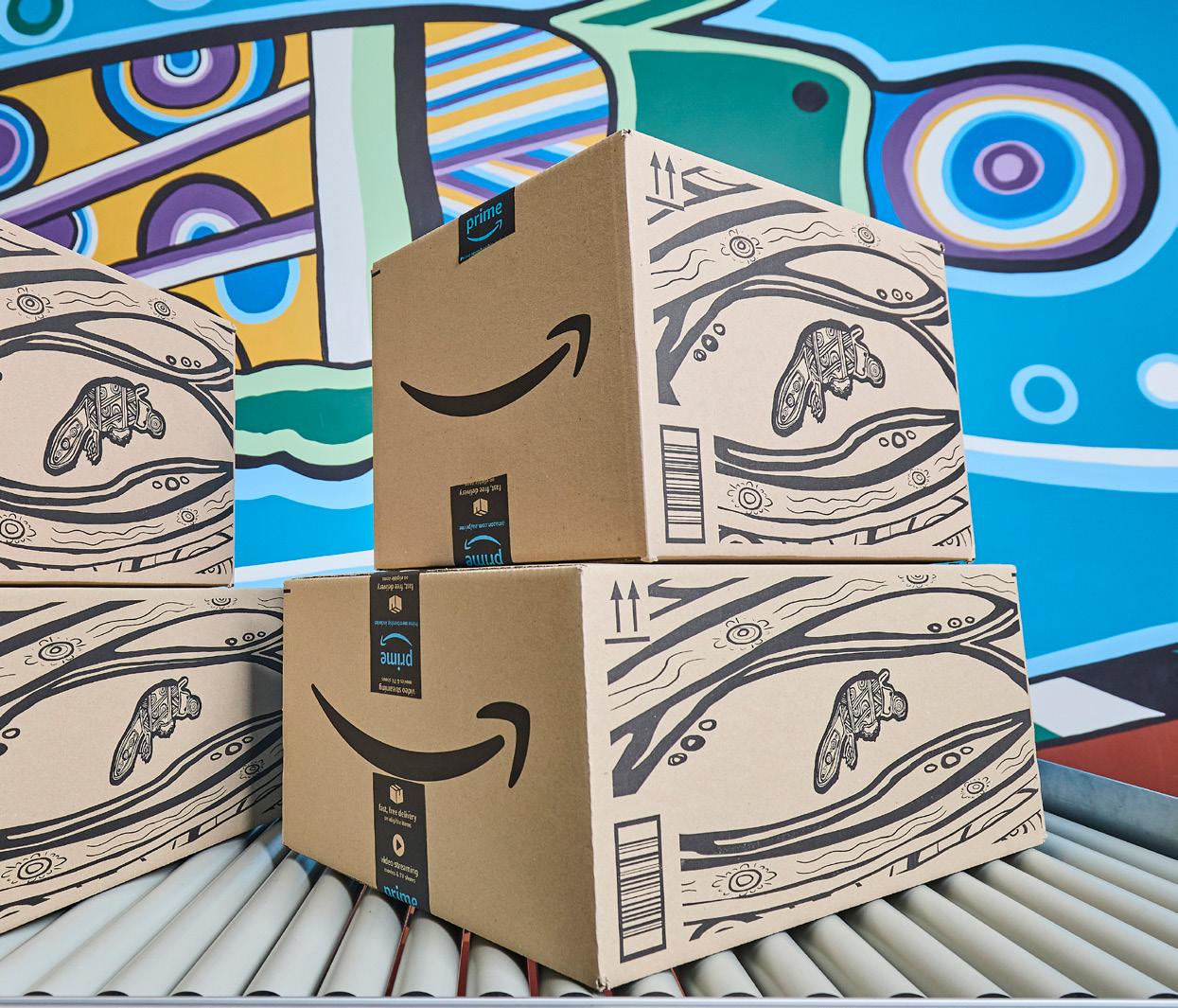
fulfilment centre in the city, our customers in Perth will be able to access an even greater selection of items that can be shipped quickly. This will be a huge win for the region”
KELLY GODSCHALX PROCUREMENT OPERATIONS MANAGER, AUSTRALIA & SINGAPORE, AMAZON


As Australia’s leading unattended micro-market operator, Morsl provides employees with convenient access to fresh, nutritious food and drink options 24/7, making it easy for them to make healthy choices.


Find out more







Discover how Morsl’s health-focused micro-markets create healthier, happier & more productive workplaces through the lens of Amazon Australia
Morsl, Australia’s leading provider of healthy workplace food solutions, is dedicated to enhancing workplace culture, employee engagement and fostering a positive work environment. Founder and CEO, Karla Borland, expresses its mission as transforming workplaces into healthier, happier and more productive spaces.
Borland explains: “We do that via our core offering of self-service cafes (micro markets), providing 24/7 access to fresh and healthy food throughout the entire workday. We also provide coffee, breakroom procurement, event catering and employee engagement events across the entire calendar year.”
A testament to Morsl’s success is its presence in the massive Amazon BWU2 fulfilment centre in Australia. Kelly Godschalx, Amazon’s Regional Procurement Operations Manager, describes BWU2 as Amazon’s largest fulfilment centre
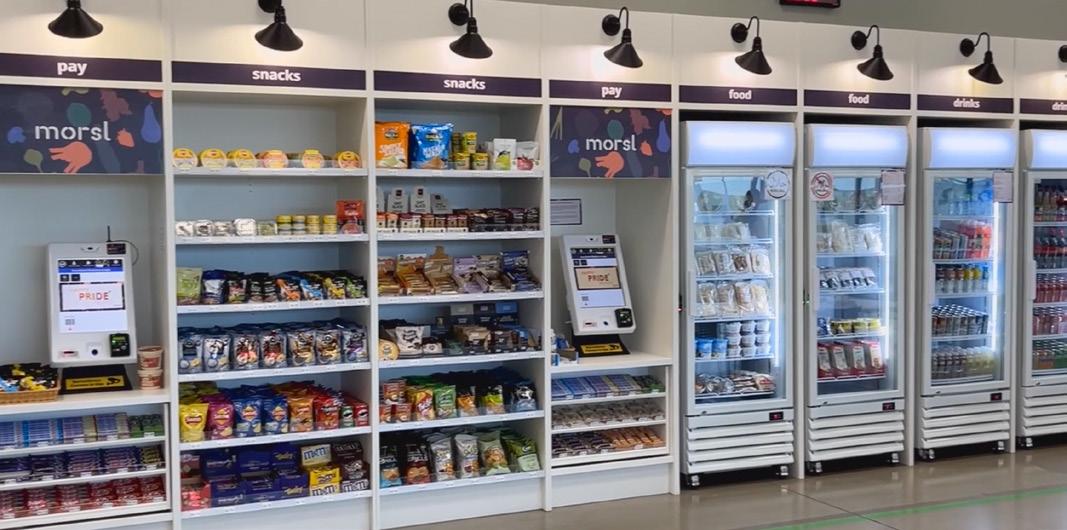
in the southern hemisphere. It spans more than 200,000 square metres across four levels. Considering the location of BWU2, in an area with no surrounding food options, an on-site solution was a must. However, choosing Morsl over other options was a strategic decision for Amazon. Godschalx highlights Morsl’s space efficiency and cost-effectiveness, stating: “Morsl is a very space-efficient, cost-effective solution that allows us to service the fulfilment centre, so that our 2,000+ associates have access to healthy food and beverages, while only taking up a small floor space.”
At its core, Morsl’s primary focus is to improve employee wellbeing by promoting healthy eating habits. Good nutrition is particularly important in the industrial space to maintain overall productivity and manage the effects of shift work. Morsl’s holistic range of services makes it an ideal partner to meet all on-site food and beverage needs, while fostering healthier eating habits, employee engagement and wellbeing. One of Amazon’s core cultural values is the equitable treatment of all associates, and Morsl’s flexible solutions achieve this with ease, offering the same great level of service to day and night staff alike.
for providing safe and inclusive workspaces, and promoting a sustainable future”, Godschalx shares.
“I want to ensure Amazon Australia is a great place to work, while specifically making procurement a desirable career path for individuals to pursue”, Godschalx says. “Sustainability is incredibly important to me, because essentially, I believe that sustainability comes down to respect. We have to respect the world that we live in – if we don’t, we’re not really respecting ourselves.
“Likewise, Amazon is committed to investing and innovating in sustainability across its businesses to create a more sustainable future. As a company, we know we have more work to do and will continue to make progress towards becoming a more sustainable business.”

“Amazon is committed to investing and innovating in sustainability across its businesses to create a more sustainable future”
KELLY GODSCHALX PROCUREMENT OPERATIONS MANAGER, AUSTRALIA & SINGAPORE, AMAZON

One company located in the heart of Australian coffee culture is single handedly changing the reputation of commercial coffee solutions by combining great tasting coffee with industry leading service at companies like Australia Post, Amazon and ANZ

Santo Buccheri, founder of the Buccheri Group / Coemenate, pours his passion for coffee and sustainability into every cup served across Australia
Santo Buccheri founded the Buccheri Group / Coemenate through a passion for fine coffee. The perfect blend of rich Italian and Australian roots and a firm belief in community, Santo wanted to share that passion with the Australian coffee community.
Santo built the successful business through hard work and dedication, and that can be tasted in every cup – savoured by people at hundreds of cafes all over Australia and New Zealand, but also at companies like Amazon, Woolworths, Australia Post, ANZ, Suncorp, Medibank, and many others. “We are unique in that we are an Australian, family-owned business,” says Santo. “You just don’t see that at the level that we operate at, supplying Australia’s biggest and most well known companies.
“But ever since I started Coemanate, the focus has been on creating a business that can evolve with our customer’s needs, regardless of their size. From the smallest cafes to the largest corporate office buildings.” Buccheri Group / Coemenate help their growers invest
long term in their future by buying high-grade coffee at a premium. This helps them secure the future of their own families and communities.
It is important to understand the whole ‘ecosystem’ of the coffee’s journey, right down to which beans grew in which field. By buying direct from suppliers, Buccheri Group / Coemenate can see for themselves the impact they are having on local communities across the supply chain.
As well as green bean sourcing, careful roasting, and bespoke coffee solutions, Buccheri Group / Coemenate provide barista training, the kind of highly personalised customer service you would expect from a family business, and 24/7 technical service.

“That culture of staying agile and being able to respond to the individual needs of every one of our customers, that’s exactly why our customers like us,” says Santo.
If you want to bring cafe style coffee into your office, contact us for a free trial

60% Amazon will be opening a new fulfilment centre in Perth to increase its Western Australian operations by 60%
Packaging is one of the key focus areas for Godschalx and her team. Amazon is committed to delivering products safely while innovating to find new ways to reduce packaging and increase recyclability.
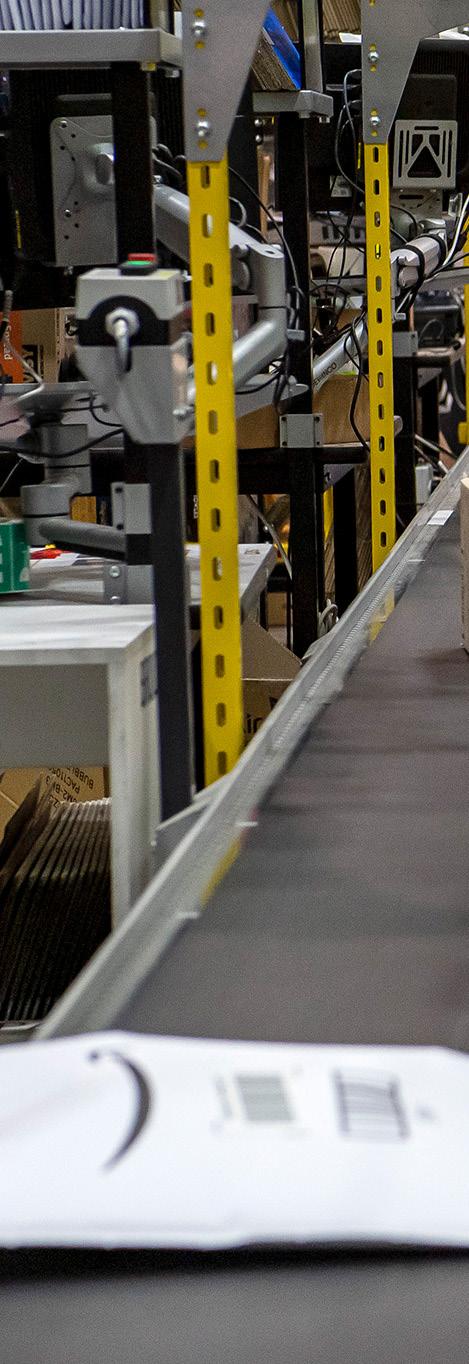
In Amazon’s Australian fulfilment network, boxes are 100% recyclable and the company has replaced all plastic, single-use air pillows with recyclable packing paper on orders shipped from its fulfilment centres. Amazon has also reduced the amount of paper used in its boxes to minimise cardboard usage. Globally, since 2015, Amazon has reduced the weight of packaging per shipment by 41% on average, avoiding more than two million tons of material waste. Where possible, the company has eliminated packaging altogether. In 2022, 11% of all packages shipped globally were without added Amazon delivery packaging.
Godschalx’s team also oversees waste services at all of the business’ 20 operations sites across Australia and Singapore.
She adds: “We have established relationships with local suppliers and have set up processes, ensuring that we’re improving our waste and recycling practices.”
Since 2015, Amazon has reduced the weight of packaging per shipment by 41% on average, avoiding more than 2 million tons of material waste
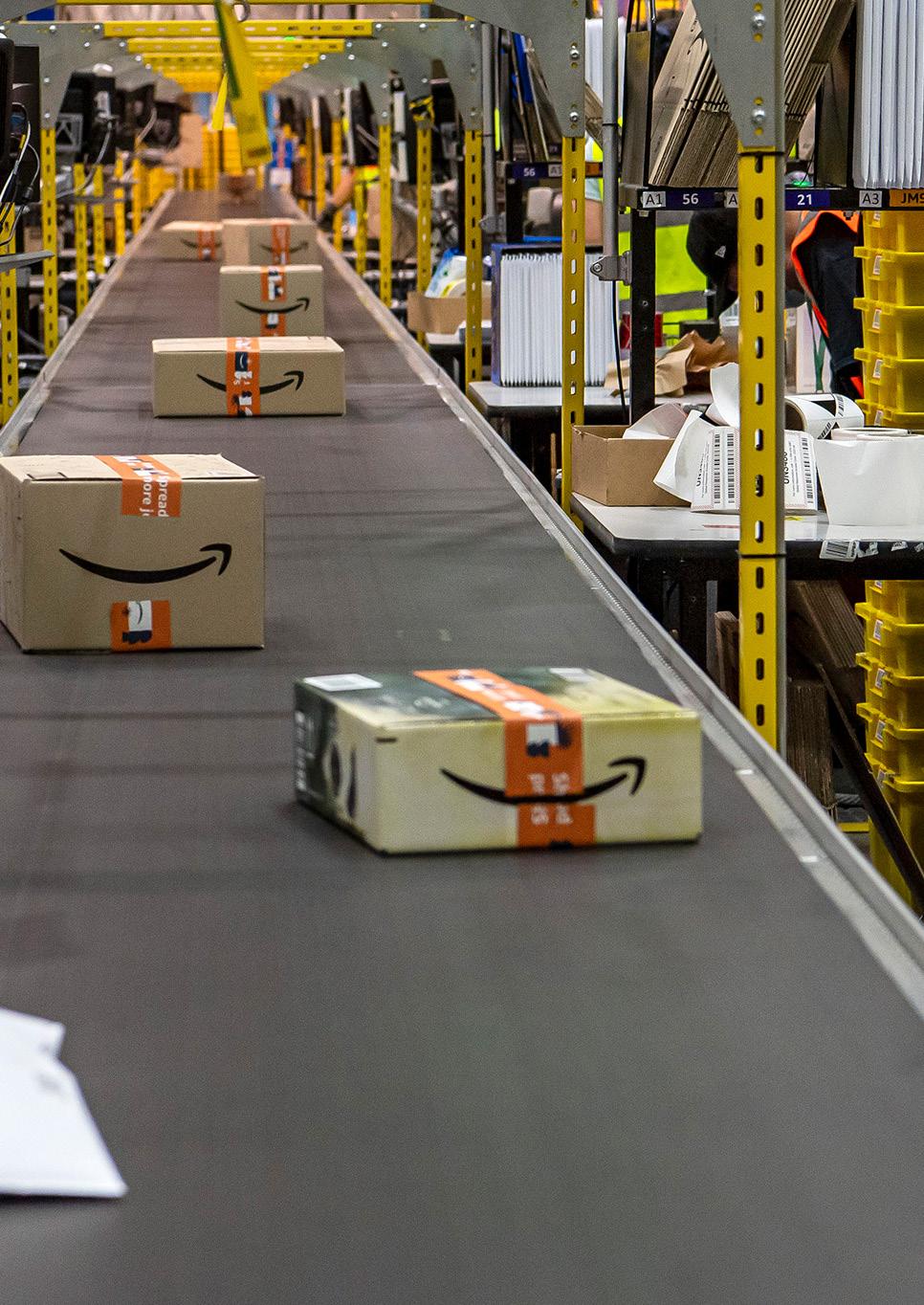 Amazon Fulfilment Centre in Moorebank, Sydney
Amazon Fulfilment Centre in Moorebank, Sydney
GO2 Partners is your preferred industrial sustainable distributor, delivering billions of labels annually. While supporting the ever-changing needs of our client, GO2 provides unprecedented assurances against halted distribution lines, unreliable supply chains, and achieving sustainability goals – delivering mission-critical labels on target, on time, and on budget.

Learn more at go2partners.com

GO2 Partners loves a challenge! We take our client’s biggest pain points and deliver innovative, custom solutions. From improving your carbon footprint and obtaining sustainability goals, to simply ensuring you do not run out of labels, GO2 Partners strives to improve your business!
GO2 Partners does this by:
• Supplying superior products such as Labels, Commercial Printing, Promotional Products, and Packaging
• Providing world-class customer service
• Creating unique solutions with our Product Development Services Team
• Utilizing an extensive, Global Distribution Network to store and ship your critical supplies

• Testing your Labels in our In-house Quality Lab before they hit your distribution floor
• Providing Marketing, Technology Services, and Data Analytics to further business growth
• Helping our customers with technology platforms such as Hubspot to achieve CRM goals
• Deploying Specialized Business Teams to help with your specific needs
Learn More!

“Thinking locally, but using our global presence to leverage new relationships, allows Amazon to maintain the ‘local’ element we’re all so passionate about”
KELLY GODSCHALX PROCUREMENT OPERATIONS MANAGER, AUSTRALIA & SINGAPORE, AMAZON

Over the past three years, Amazon’s Global Procurement Operations Organisation has been going through a global transformation, which has involved procurement teams working together in a bid to ‘think global, act local’. It means countries like Australia and Singapore can share insights and learnings with teams from the US, Europe and South America.
“We have global categories set up, but given the nature of our operations business, it’s important to us that a lot of what we do is produced locally,” says Godschalx.
“We have set up local operations for particular non-inventory items. We also need to have a lot of on-site services, such as those for food, waste, pallet management and hygiene services, as well as pest control. These often need to be managed by local providers and suppliers as well.”
Godschalx shares an example of how Amazon was previously importing one particular item from the US to Australia, which took around six months. To overcome this, Amazon partnered with a global supplier to find a local Australian supplier, who they could work with to set production up within the country. This reduced that six-month time period to just one week.
“Thinking locally, but using our global presence to leverage new relationships, allows Amazon to maintain the ‘local’ element we’re all so passionate about, while also ensuring we’re able to deliver to our customers on time.”
Godschalx continues: “I’m really excited about the future of the company, and to see how my team and I can continue to make a positive impact.”
Amazon’s Global Procurement TransformationThe Global Supply Chain Awards 2024 will be celebrating the very best in Procurement & Supply Chain with the following categories:
Procurement Transformation Award
–Digital Supply Chain Award –Global Logistics Award –Supplier Diversity Award –Supply Chain Innovation Award –Supply Chain Sustainability Award –Procurement Technology Award

Procurement Consultancy Award –Future Leader Award –Executive of the Year Award –Project of the Year Award –Lifetime Achievement Award
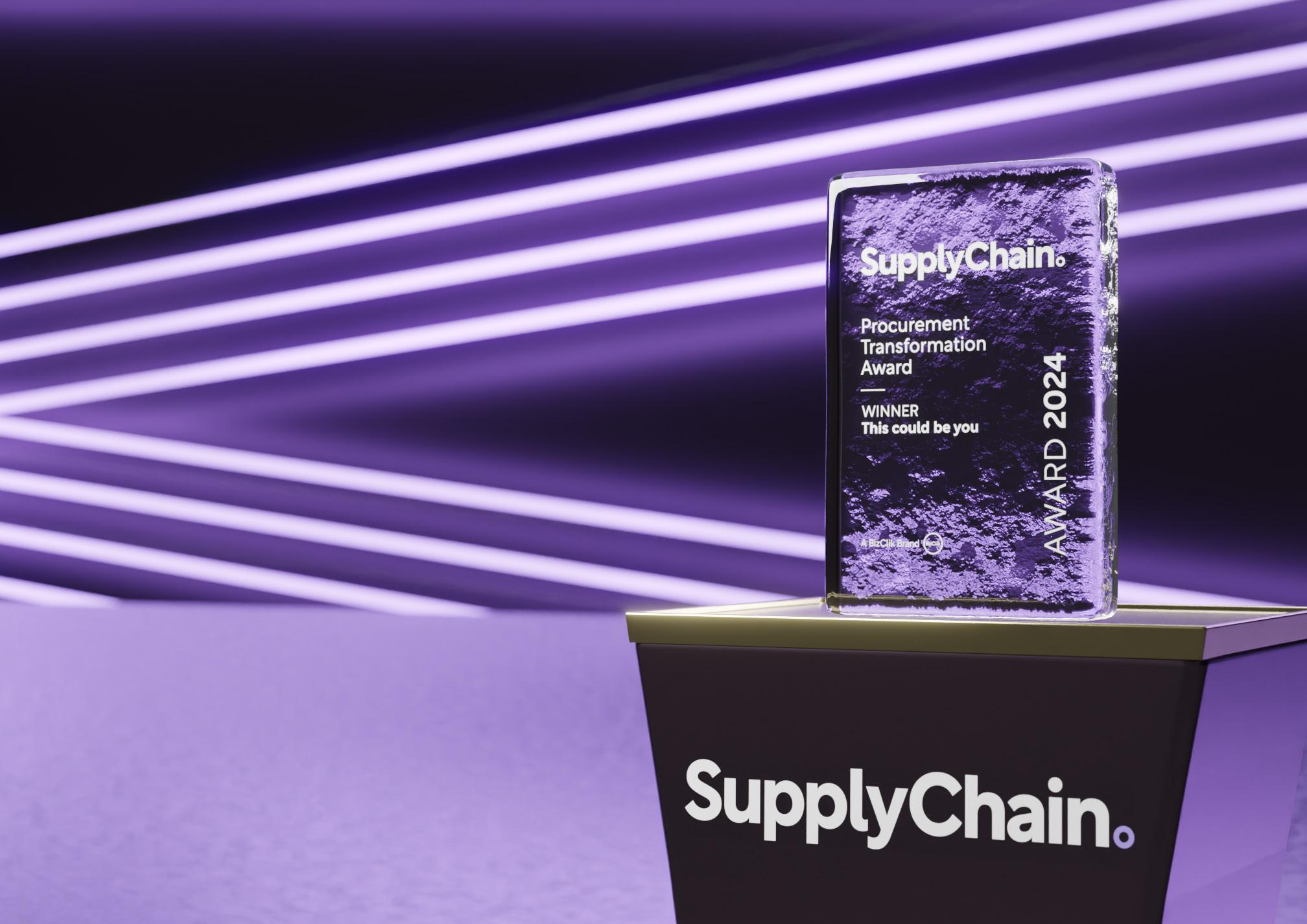


Without negotiation, procurement is bound to fail. Without strategy, negotiation is a shot in the dark. Nicolas
Walden & Vineetha Jayaram illuminate the process WRITTEN BY: ILKHAN OZSEVIMNegotiations play a vital role in shaping outcomes and fostering mutually beneficial relationships, and in our postpandemic world of disruptions, this is more important than ever before. To gain valuable insights into effective negotiation strategies, two industry experts, Nicolas Walden and Vineetha Jayaram, share their perspectives on the subject.
As seasoned professionals in their respective fields, their expertise offers valuable guidance for organisations seeking to optimise their negotiation practices.
Negotiation is an art, and some may even venture to call it a science. But like every skill set, there is some necessary level of strategy involved. But why do organisations
need to be strategic when it comes to their negotiation strategies?

Nicolas Walden, Associate Principal and UK & Europe Practice Leader, Procurement Advisory at The Hackett Group, emphasises the significance of strategic negotiations in achieving win-win outcomes. He states, “Strategic negotiations allow both parties to win, and we do this through using facts to understand, then to shift each parties’ interests, to a joint position where each party receives a benefit or gain.
“This strategic, interest-based approach is preferred over more traditional positionbased approaches where one party to the negotiation wins and the other loses as we attempt to shift people to our preferred position.”
Gain visibility into rebate program performance
Easily calculate, pay, accrue and forecast your rebates
Grow stronger trading relationships

Vineetha Jayaram, Global Supply Manager at nVent and expert in contract negotiations and high-pressure environments, expands on the importance of strategic approaches. She explains, “Negotiations including formal business agreements are never straightforward transactional discussions. By adopting a strategic approach, organisations are able to proactively assess the different variables in the negotiation including the issues, opportunities, and potential setbacks to derive the maximum value and the most favourable outcomes.”

She says this is especially beneficial in contract negotiations and in high-pressure high-stakes environments. “Developing a strategy related to the agendas, and interests of the other party, aligning on the risk-mitigating solutions for the points of contention, and clear

communication of those solutions to the counterparties is crucial to build trust during the negotiation process and achieve the best results for both parties.”


Both Walden and Jayaram acknowledge the challenges that organisations face when adopting a strategic negotiation approach. Walden points out, “Hackett survey data shows that buyers are only fully prepared for negotiations around 70 percent of the time. Moreover, around 75% of the time, it is inadequate preparation time that is the driver of this gap. It is essential to allocate sufficient time and effort to adequately prepare for the negotiation, and following key negotiating best practices helps us to prepare adequately and confidently.”
Jayaram adds, “The primary challenge is the additional investment in time and resources required in developing the strategy for implementation during the negotiation. It is crucial to determine the
negotiation tactics and styles to be applied which are aligned with the personality profiles of the team members and the opportunities in the relationship to significantly improve the upside or limit the downside.”
She believes the other issue in developing an effective strategy is not having clear goals for the outcome of the negotiation that is detailed enough to eliminate ambiguity and is also delivering value to the counterparty involved.
“Another obvious hurdle,” she says, “is not having enough data or information
NICOLAS WALDEN ASSOCIATE PRINCIPAL AND UK & EUROPE PRACTICE LEADER, PROCUREMENT ADVISORY,THE HACKETT GROUP
“
There are two main negotiation types. The first is position-based, where one party wins while the other loses. The second is interest-based, where both parties can win”
about the counterparties’ perspectives, interests, and bottom line. Inadequate preparation and planning can be a serious setback for defining and executing a negotiation strategy.”

When it comes to negotiations, both Walden and Jayaram emphasise certain fundamental principles that contribute to successful outcomes.
Walden thinks that suppliers will likely invest significant resources and time into developing their negotiating approaches,
 Nicolas Walden
Nicolas Walden
tactics and communications. He says buyers must also allocate time to prepare, analyse and plan in order to generate improved outcomes.
“Fundamental activities include mapping out the key issues and discussion points; using data and insights to understand buyer and supplier positions and personalities; determining suitable negotiation targets and opening positions; developing a specific negotiation plan with structured interactions; planning the different roles and subject matter experts needed as part of the efforts; and documenting the final agreements on each of the issues.”
Jayaram further elaborates on the fundamentals of negotiations: Communication: “It is crucial to focus on body language and listen carefully prior to speaking in the negotiation process,” Jayaram advises. Other actions include “anchoring” and “framing” the discussion, going first when it is time to make an offer
or proposal, asking both clarifying and open-ended questions on the primary points of contention, and summarising the key outcomes at the end of the negotiation. Relationship Focus: Prior to the negotiations, Jayaram suggests, “there should be a careful examination of the type of relationship to be established and maintained.” In an interest-based negotiation, emphasis should be placed on maintaining trust and decorum during interactions to arrive at mutually beneficial outcomes for both parties involved.
Interests: To ensure a collaborative and creative negotiation process, Jayaram emphasises the importance of clear alignment on the goals and desired outcomes of both parties. She advises posing clarifying “why” questions related to the counterparty’s interests during the negotiation.
Options: Exploring and sharing possible deals that provide value to both parties

is essential. Jayaram emphasises the need to highlight the value of anything offered or given up to achieve a win-win deal.
BATNA: Both Walden and Jayaram stress the significance of identifying alternatives. Jayaram explains, “Identify your alternatives including Best Alternative to a Negotiated Agreement (BATNA) and those of your counterparty to determine your walkaway threshold to ensure you are not accepting a deal that does not meet your expectations.”

Standards and Commitments: Jayaram emphasises the importance of justifying proposals and utilising objective criteria to measure the value and fairness of the agreement. It is crucial to understand the counterparty’s rationale and legitimate issues. However, she warns against negotiating against one’s own interests. Additionally, clear understanding of the commitments that both parties are willing to make with the agreement is vital.

VINEETHA JAYARAM GLOBAL SUPPLY MANAGER, NVENT
“Prior to negotiations carefully examine the type of relationship you want to establish and maintain”
Walden explains, “There are two main negotiation types.” The first is position-based, where one party wins while the other loses. What Walden calls “position-based” is referred to as “zero-sum” in game theory and economic theory.


Walden says, “It is subjective and individual-oriented, aiming to shift the other party to a preferred position. The second is strategic or interest-based, where both parties can win. This type of negotiation relies on facts, expertise and understanding to reach a joint position where both parties benefit.”
To ensure successful negotiations, Walden suggests several best practices. He advises organisations to ensure that any musthaves or pre-qualification requirements are already satisfied ahead of the negotiations. Obtaining buy-in from leadership to the negotiation strategy in advance provides further clarity on positions and interests.
Walden emphasises the importance of forming the negotiation team with absolute
clarity on roles and responsibilities, as well as any subject matter experts needed. Planning the negotiation approach in a structured manner, considering interests, key terms, and issues to be negotiated, tailored to the personalities of the people involved, is crucial. Lastly, documenting
VINEETHA JAYARAM GLOBAL SUPPLY MANAGER, NVENT
“Negotiations are never straightforward, so by being strategic organisations can proactively assess the variables”
positions and updating them as the negotiation progresses allows for agile responses to offers and avoids misunderstandings.
Buyers
Walden suggests utilising a range of tools and technologies to support negotiations. |He mentions that at the low-tech end, simple templates can be used to map out interests and consider different approaches and counters. At the higher-tech end, game theory AI simulation apps and tools enable teams to practise and refine strategies and tactics in safe environments. He also mentions the existence of “negobot” technologies used by some companies to haggle with suppliers and deliver additional savings value.

Considering the challenges and the importance of strategic negotiations, Walden highlights the need for proper investment in strategic partnerships and relationships.
He also emphasises the significance of improving strategic negotiations to navigate challenges successfully, since strategic negotiation strategies empower organisations to go beyond mere transactional discussions and foster mutually beneficial outcomes. By embracing a strategic approach, organisations can navigate complex negotiations with confidence, build stronger relationships and achieve long-term success.
 WRITTEN BY: ILKHAN OZSEVIM
PRODUCED BY: LEWIS VAUGHAN
WRITTEN BY: ILKHAN OZSEVIM
PRODUCED BY: LEWIS VAUGHAN
IMAGES: NTT

The world of data centres, their construction and development is closer to home than most assume. They form the foundation of our interconnected world, housing the very architecture that carves out our modern society.
We take a look at this foundation through the eyes of Brittany Miller, Senior Vice President of Construction, Engineering, and Supply Chain at NTT Global Data Centers.

With a remarkable professional journey and a wealth of experience in the industry, Miller shares valuable insights on the process of building and developing data centres, with a particular focus on cost efficiency, and brings a diverse background to her current role. Her journey began at Intel Semiconductor Company, where she gained invaluable experience in building chemical and gas fab plants across various locations worldwide.
Working in a rapid-paced and everchanging environment, Miller developed expertise in construction and supply
chain management, successfully navigating complex, fast-paced projects while honing her skills in risk management.
After her time at Intel, she transitioned to the data centre industry, joining Microsoft in roles that involved both the construction and lease acquisition sides of the business. This diverse experience laid the foundation for her current position at NTT, which she assumed nearly three years ago with the aim of establishing a scalable delivery organisation.
To provide context, NTT is a prominent Japanese-based global technology company, with over 150 years of aggregated corporate technology innovation under its umbrella and a strong presence in the global data centre industry.
NTT boasts an impressive network of data centres across North America, Europe, India, and APAC. Miller says that, “while the intricacies of NTT’s organisational structure are vast, for the purpose of this discussion,
we will focus primarily on the data centre business segment.”
NTT is a company that’s actively focused on the pursuit of cost efficiency in data centre construction and development, as Miller highlights: “Given the capital-intensive nature of building data centres, it is crucial to manage costs effectively without compromising on quality or performance.”
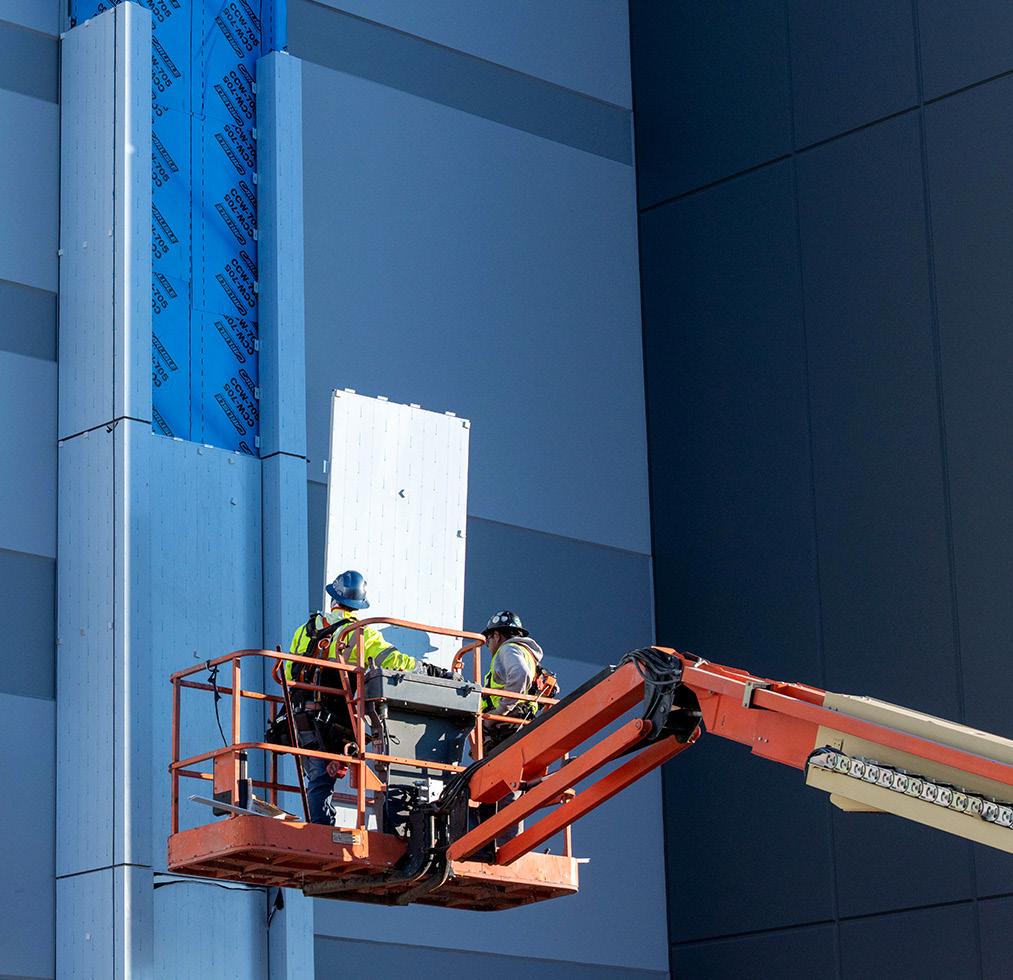
“It is crucial to manage costs effectively without compromising on quality or performance”
BRITTANY MILLER SVP OF CONSTRUCTION, NTT GLOBAL DATA CENTERSConstruction teams at NTT’s Phoenix data center campus
Miller emphasises that a comprehensive understanding of different delivery models and effective risk management are essential in achieving cost efficiency. Drawing from her experience, she highlights the importance of strategic planning, meticulous project execution, and a relentless focus on scalability.
Under Miller’s leadership, NTT’s delivery organisation has experienced significant
growth, quadrupling in size over the past three years. This expansion has been accompanied by the opening of new markets and the establishment of build-to-suit capabilities – solidifying NTT’s position in the Americas.
When it comes to finding success in building and developing data centres, Miller highlights the importance of cost reliability. She explains that their journey began with a focus on standardisation. By understanding customer requirements and aligning them with their business model, they were able to standardise their product in the US. Starting with their Phoenix Campus

“People leave bad leaders, not bad companies”
BRITTANY MILLER SVP OF CONSTRUCTION, NTT GLOBAL DATA CENTERS
project, they replicated the design across all sites, which not only provided a better understanding of costs but also allowed them to identify and implement cost efficiencies.
“Standardisation has been key in improving predictability, cost control and scalability, while still accommodating necessary design innovations to meet client demands,” she says.
Similar to their cost efficiency approach, Miller underlines the significance of standardisation in managing project schedules effectively: “By adopting a basebuild core design approach, we created the infrastructure necessary to deliver capacity in alignment with demand curves.
TITLE: SVP CONSTRUCTION AND CRITICAL FACILITIES ENGINEERING AND DESIGN
COMPANY: NTT GLOBAL DATA CENTERS
Brittany Miller leads new data center construction projects which feature global industry standards, multi-story buildings, and massive capacity.


Prior to joining NTT, Miller spent four years leading teams in Microsoft’s Cloud Operations and Innovation business unit, helping to meet the unique challenges of a rapidly growing global business. She led a team that was responsible for global program management and governance along with AMER lease execution.
Previously, Miller held multiple positions at Intel over her 10-year tenure there. She led a global team of supply chain professionals from setting construction delivery strategy through the execution of large-scale construction projects.
Empty data hall at NTT data centrePURSUING THE GOAL OF A NET-ZERO FUTURE FOR DATA CENTERS WORLDWIDE.

Gary Johansen, VP Engineering at Cummins discusses how the business is working with clients and utilising new technology to achieve zero-emissions.
Operating in 190 countries with more than 70,000 employees, Cummins is a global enterprise and energy-to-power solutions provider. The business is driven by the goal of providing the right solutions for its customers to promote their sustainability ambitions, whether that’s regarding environmental, economic or community sustainability.
Destination Zero highlights Cummins’ ambitious goal of adopting a zeroemission footprint by 2050, through achieving zero emissions, waste and water usage within its operations. This not only applies to Cummins but to the business’ products in use too, as Cummins’ customers use fuel to operate the products, which of course, generates a carbon footprint.

To achieve these goals, Cummins is investing in a broad array of technologies that the business believes are meaningful and important for future

sustainability efforts. For example, Cummins is investing in fuel-cell technology through zeroemission space Accelera, which is converting hydrogen energy into electrical power. “We also recognise that battery energy storage is a very critical part of many of our applications moving forward,” Johansen says. “So, we’re investing in battery energy storage and fuel cell technologies, while also advancing core technologies of today, including internal combustion engines to run on low and no carbon fuels.”
Additionally, Cummins has also been advancing internal combustion engine (ICE) efficiencies and emissions for decades – and continues to provide heavy investments. “Our exhaust emissions technology and other critical components, such as fuel systems, air handling systems and electronic controls are all critical to reducing emissions and improving fuel efficiency,” Johansen explains.
“The world needs us to decarbonise our infrastructure, and Cummins is providing opportunities to do so, as we serve so many which are crucial to our communities. Because of this, I don’t think there’s ever been a more exciting time to work at Cummins, or in the power space.”
LEARN MORE MILLER SVP OF CONSTRUCTION, NTT GLOBAL DATA CENTERSThis strategic approach allowed us to scale rapidly while also providing flexibility to adapt the product based on customer requirements.”
Addressing the topic of scale, Miller underscores the two primary tenets that drive the company’s approach: cost predictability and scalability. Through their standardisation efforts – and the subsequent ability to streamline operations and improve efficiency – NTT has successfully achieved scalability while maintaining cost control and project predictability.
As we all know, supply chain challenges have truly been redefined in recent years, and it’s
 BRITTANY
BRITTANY
“Standardisation has been key in improving predictability, cost control and scalability, while still accommodating necessary design innovations”
NTT’s Silicon Valley SV1 Data Center
no hyperbole to say that these disruptions have been unprecedented.
“However, by partnering with multiple suppliers in each equipment category and sharing our roadmap transparently, NTT ensures that suppliers have a clear understanding of our requirements.
“This collaboration enables effective planning, proactive decision-making and better management of supply chain risks,” she says.
Additionally, she points out that the standardisation of equipment across sites, allows NTT to leverage flexibility and move equipment as swiftly as needed, ensuring timely delivery: “Early commitment and close communication with partners facilitates timely responses to potential impacts during the production stage,

enabling us to make informed business decisions and agile adaptations.”
The importance of having good people at NTT
Miller emphasises the crucial role of having a talented and dedicated workforce at NTT. “Hiring the right people and providing them with the right support enables them to take ownership of projects and make decisions that impact NTT’s overall success,” she says.

She draws from her experience at large tech companies, where working at a fast pace under pressure can be challenging.
“I believe that enjoying the work environment and having positive relationships with colleagues are essential for a fulfilling experience in any company.
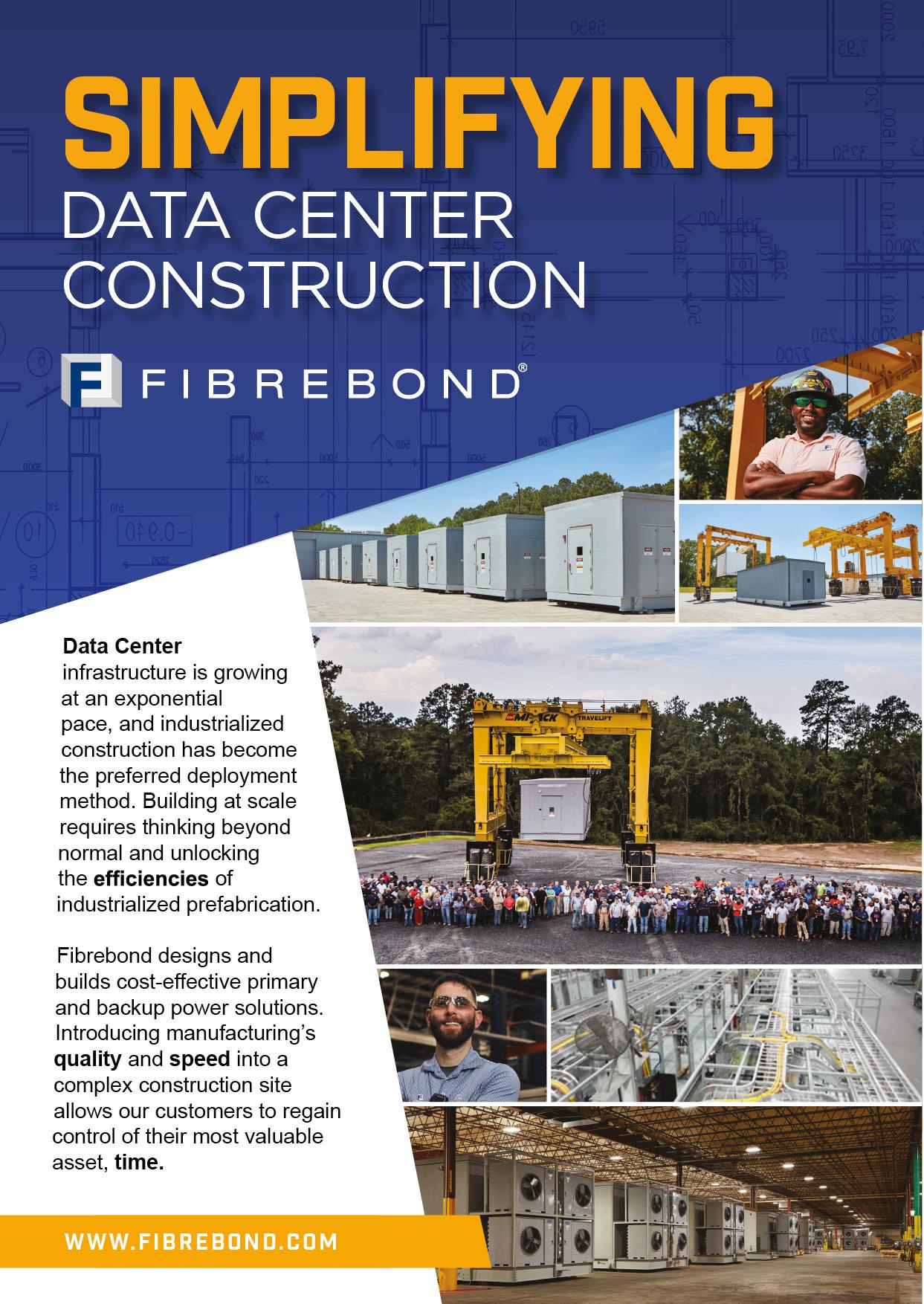
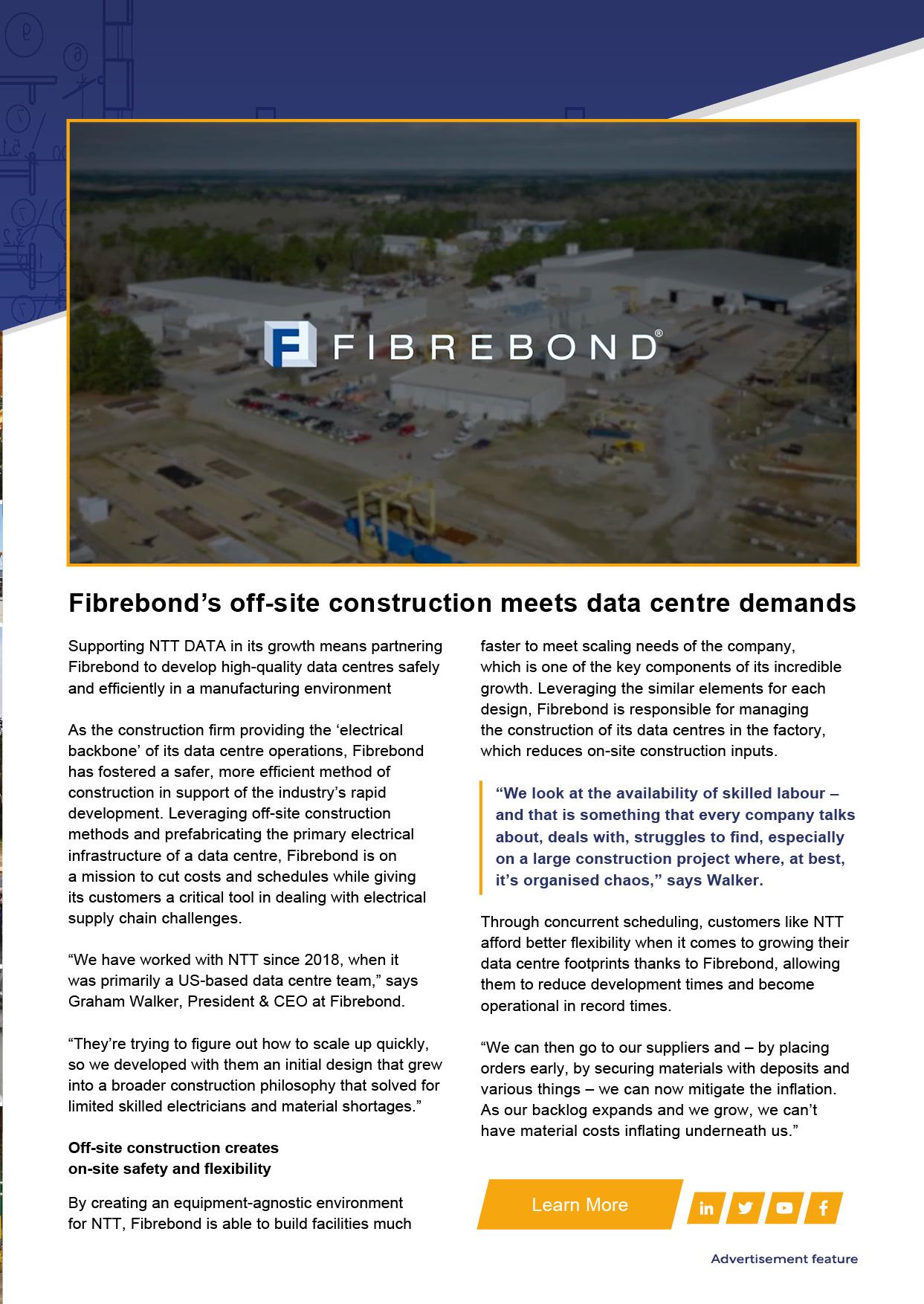
As the saying goes, ‘people leave bad leaders, not bad companies’.”
To create a workplace where people enjoy coming to work and working with their colleagues, Miller focused on building a strong team. Though many positions were initially outsourced, she took the time to carefully select the right leadership team.
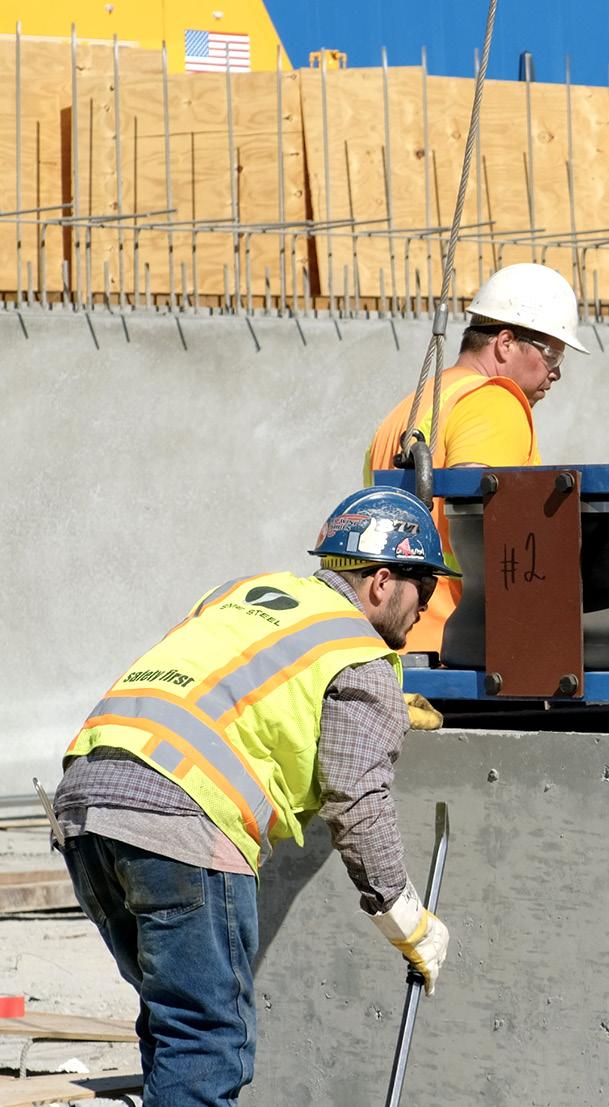
“This deliberate approach paid off, contributing to the team’s ability to scale rapidly and quadruple the business in just three years,” she says. “The people and leadership drive this success, and my leadership style involves regularly checking in with team members and addressing any roadblocks.”
In terms of team composition, Miller believes it starts with establishing the desired culture and vision. NTT’s culture revolves around connecting people and enabling them to deliver, while the vision is to scale rapidly and enter new markets swiftly.
“With these goals in mind,” she says, “the focus was on building a diverse leadership team with varied backgrounds. The team includes individuals from the data centre industry with hyperscale knowledge, as well as professionals from adjacent industries like hospitals and semiconductors.”
NTT also recruited people with deep expertise in supply chain management, “even if they had no prior tech experience”.
“Despite the fast pace of work, leaders should remember that it is the collective effort of the people that drives the success of an organisation”
BRITTANY MILLER SVP OF CONSTRUCTION, NTT GLOBAL DATA CENTERS
“By bringing together diverse perspectives and capitalising on the strengths of each team member, we were able to create a cohesive and highly effective team,” she says.
Miller gives prominence to the fact that the success of the leadership team led to the replication of this approach throughout the organisation, ensuring a consistent and aligned mindset.
“The concept of ‘winning together’ resonates with the team, as all functions, including engineering, construction, and supply chain, operate under the same organisational umbrella.
“This integrated approach encourages collaboration and shared responsibility in problem-solving. The team fosters a culture of innovation, understanding that taking risks and learning from failures are vital for growth and improvement.”
To further strengthen the team and address the industry’s talent shortage, NTT has launched an internship programme in their construction organisation. This initiative aims to develop young talent and inspire them to pursue careers in the data centre industry. By providing valuable industry exposure and experience, NTT hopes to retain talent within their



organisation and contribute to the industry’s growth as a whole.
Since implementing the right teams throughout the organisation, NTT has experienced significant changes. One notable improvement has been a reduction in attrition, which had been high in the industry in recent years.
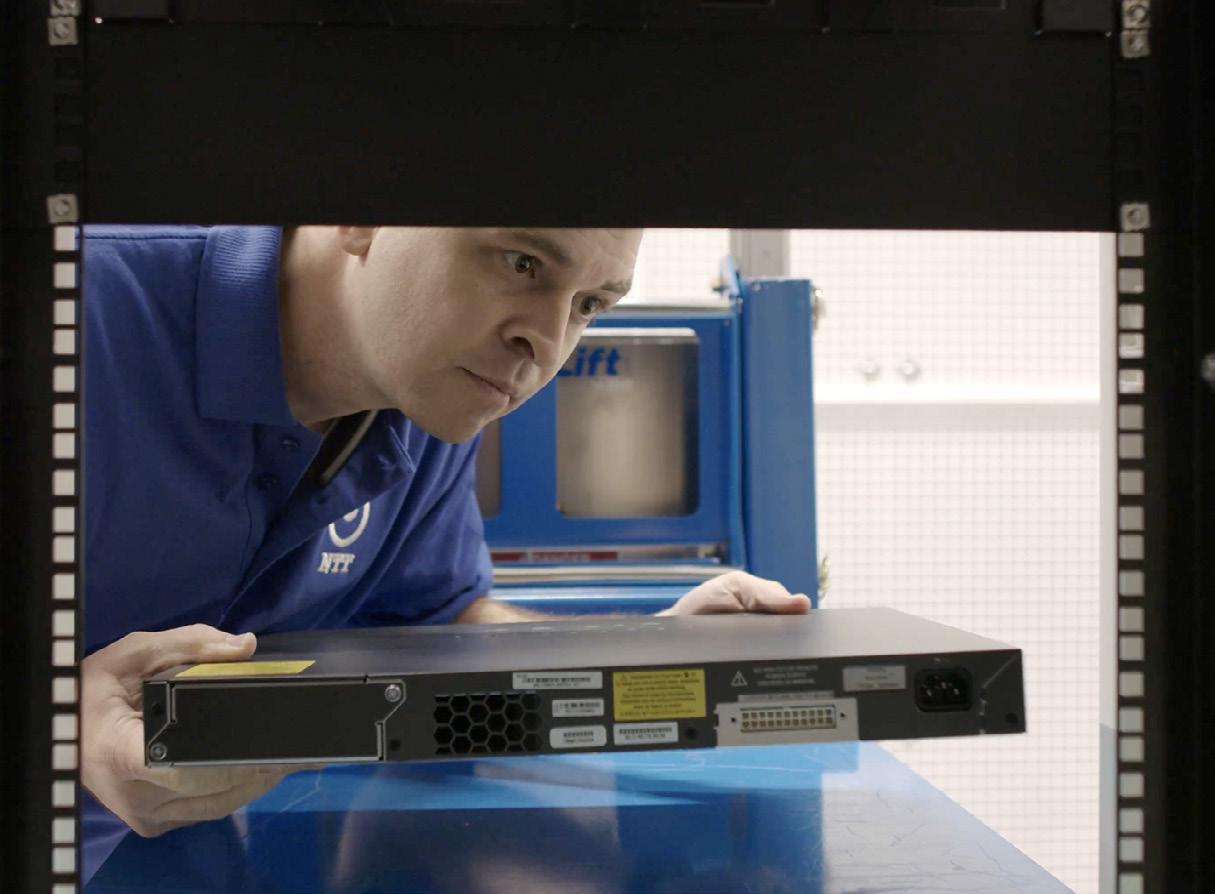
“The work being done at NTT, and the opportunity to contribute to building a new organisation with a strong foundation has generated a lot of excitement among our employees,” she says. “They appreciate the autonomy to create and improve processes, rather than following outdated methods that have been in place for many years. This sense of empowerment and continuous improvement is truly motivating for the team members.”
Miller points out that effective communication has also played a crucial role in retaining the team and fostering a positive work environment. She highlights the importance of consistently communicating the organisation’s vision and any changes that are coming.
“In fact, leaders should overcommunicate to ensure that everyone is aligned and understands the ‘why’ behind decisions and initiatives. Transparency in communication not only keeps employees motivated, but also fosters an environment of trust,” she says.
Expressing gratitude and acknowledging employees’ achievements is another significant factor in building a truly successful team.
“It’s actually very simple to say ‘thank you’ when someone does something awesome,” she says. “But it goes a long, long way.
Recognising and appreciating the hard work and dedication of team members through simple gestures like instant messages or emails can be very effective in boosting morale.”
NTT also implements initiatives such as ‘Coffee Connects’, where employees from different parts of the organisation come together virtually for a coffee break, fostering connections and collaboration. Regular all-hands meetings, monthly newsletters, and team-building challenges are other ways NTT creates a safe and open space for communication and connection.
Reflecting on her experience, Miller advises other organisations to prioritise listening.
“Truly hearing and understanding employees, whether it’s about their personal lives, challenges on projects, or any other concerns, is absolutely crucial.
“Leaders should actively remove roadblocks and support their team members. Building genuine connections with the team, remembering personal details about their lives, and showing care and support can go a long way in fostering a positive, productive work environment.

“Despite the fast pace of work, leaders should remember that it is the collective effort of the people that drives the success of an organisation,” she says.
Miller’s central message to the audience is to invest more in people, particularly in the construction industry. She says that taking care of employees and suppliers is crucial for the success of a company.
“By providing support, listening to their voices, and allowing them to be a part of the decision-making process, organisations
The explosion in demand for data centres has attracted the attention of investors of all types –growth capital, buyout, real estate, and, increasingly, infrastructure investors. In the US market alone, demand measured by power consumption –to reflect the number of servers a data centre can house – is expected to reach 35 gigawatts (GW) by 2030, up from 17GW in 2022, according to McKinsey analysis. The United States accounts for roughly 40% of the global market.
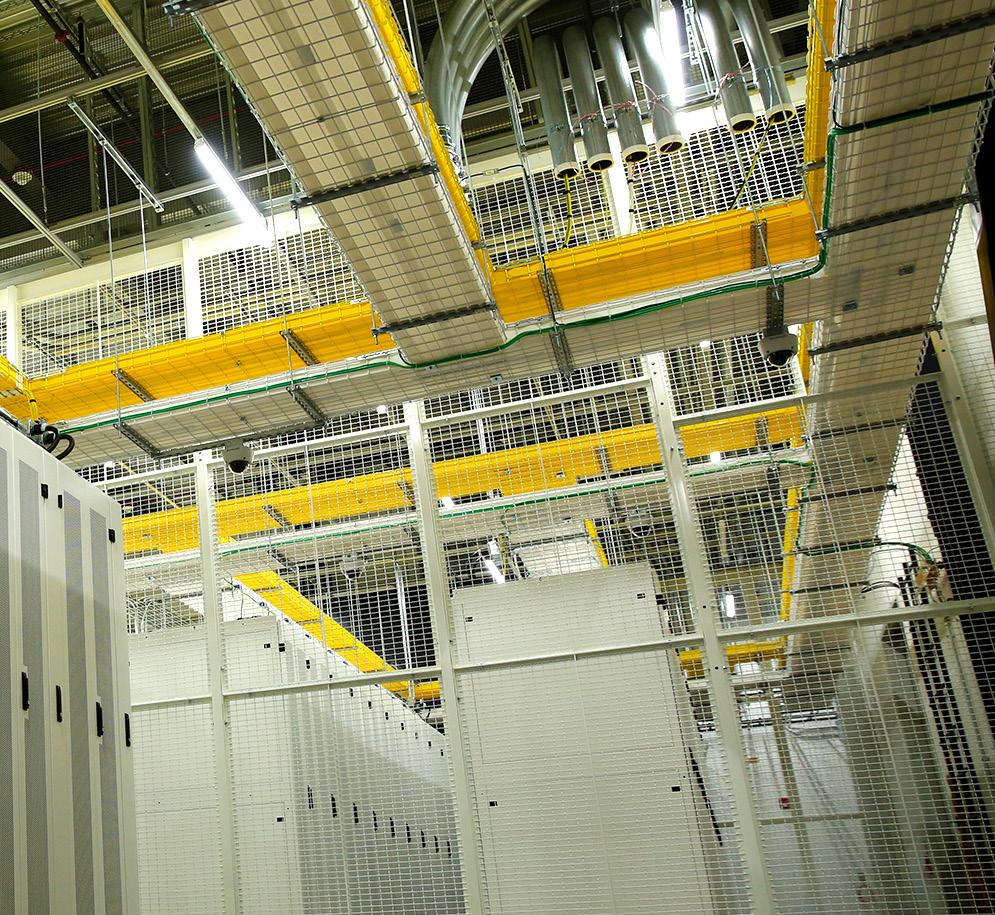
can harness the dividends of employee engagement and satisfaction.
“I believe that people want to be a part of something meaningful, especially in the post-COVID world, and involving them in shaping the organisation can yield significant benefits.”
of the people, by the people, for the people
Miller adds that construction, as an industry, is heavily dependent on people. Despite advancements in technology in various fields, the construction industry has not seen
significant progress in the last 60 years. Skilled labour in construction is limited, and there is no imminent threat of robots taking over jobs. She suggests that the industry should embrace diversity, allow people to work from different locations where possible, and challenge outdated norms.
“By prioritising the wellbeing and potential of individuals, the construction industry can unlock numerous opportunities for growth and success,” she says.
Regarding partnerships, Miller discusses three companies: Fibre Bond, Cummins, and Silent-Aire.
Fibre Bond has been a long-standing partner of NTT, helping standardise their data centres and innovate within the constraints of the industry. “Our partnership has been characterised by mutual collaboration, agility, and a willingness to challenge each other for better results – key criteria for any successful partnership,” she says.
Silent-Aire, another strategic partner, is a prominent player in the semiconductor and data centre industry. “With their reliability and substantial manufacturing capacity, Silent-Aire has become one of NTT’s primary suppliers.”

Cummins is a trusted supplier of generators in the data centre industry. “Although Cummins’ partnership with NTT is relatively new,” says Miller, “they have demonstrated reliability, effective communication of
risks, and a strong commitment to delivery.” She points out that NTT shares extensive information with their partners, allowing them to align their efforts and deliver the expected outcomes. She says the company “expects a positive future with both Silent-Aire and Cummins” as their “strategic partners”.
In the next 12 to 18 months, NTT’s focus will be on significant building projects. They have already secured customers for most of the capacity at their sites, and their major markets, including Phoenix,
Dallas, Hillsboro, Chicago, and Ashburn, will witness substantial construction, will witness substantial construction.
NTT plans to evolve their standard designs based on industry developments and address critical factors such as supply chain and power to enhance their competitive advantage in delivering future capacity.

Changes in the Industry’s Future Miller anticipates that the introduction of AI will increase spending from key technology companies and have a significant impact on the data centre industry, although the exact nature of this impact
is yet to be determined. Increased demand due to AI will likely require larger data centre footprint, which may necessitate alternative design and construction methods; as such, Miller predicts that power will continue to be a crucial conversation in the industry.
“The availability of power in different regions – such as the middle of the United States – may become a target market for companies seeking quicker access to power infrastructure,” she concludes.
The need for procurement to be more strategic is seeing more automated solutions in areas such as supplier vetting and contract renewals
WRITTEN BY: SEAN ASHCROFTOngoing supply disruption and the prevailing climate of economic and geopolitical uncertainty means there has never been a greater need for procurement to be a strategic business function. This, in turn, is driving the adoption of AI and machine learning (ML) solutions in automating the less strategic aspects of procurement –which, traditionally, have been something of a time-sink for the profession.

Procurement leaders are expected to drive the execution and management of contracts in collaboration with internal stakeholders and suppliers. Their teams, meanwhile, are also expected to contribute to the vendor management lifecycle, including areas such as ESG, risk, and performance requirements.
Today, there’s a raft of procurement automation solutions to do the heavy lifting in these and other areas.
Here, we talk to Jennifer Chaplain – Solution Engineering & Customer Engagement Principal for Aera Technology, which helps businesses use real-time data and AI to predict business risk and opportunity – about the hot areas of procurement automation, the benefits of such solutions, and how businesses can get the most from them.
In her role, Chaplain implements the company’s core technologies and also designs decision intelligence workflows for global companies. “I am a passionate evangelist for data science and machine learning to enable predictive, self-healing
supply chains,” she says. “I guide customers in transformational projects so their systems can react to supply issues autonomously and in real-time, including communication with n-tier suppliers and contract manufacturers.”
Below, she shares her knowledge and insight into procurement automation.
Procurement teams are often forced to work reactively rather than proactively. They juggle strategy and execution while making daily, even hourly, decisions; responding to supply chain and logistics volatility; managing costs and compliance; and other tasks.
“TECHNOLOGIES THAT DIGITISE AND AUTOMATE DECISIONS CAN BREAK DOWN SILOS ACROSS THE ORGANISATION THAT HIDE PROCESS GAPS”
JENNIFER CHAPLAIN ENGINEERING & CUSTOMER ENGAGEMENT PRINCIPAL, AERA TECHNOLOGY
Often, such teams have to act without full context for the decisions they make, on top of the fact that the number of decisions that must be made has grown beyond even the best team’s ability to keep up.
What’s more, procurement teams frequently rely on siloed technology systems and business processes that don’t provide real-time visibility.
In many cases, decisions are delayed by complexity amid the slow speed of human collaboration and alignment.
Information has to be gathered and analysed not just from data lakes, but spreadsheets, emails, or even faxes.
Traditional approaches to capturing knowledge and determining the best actions aren’t enough to stay competitive. True digital transformation of procurement requires technology that enables faster, more accurate decision making.
What tech innovations do you see shaping procurement?
Decision intelligence – the ability to digitise, augment, and automate decision making
– is a fast-growing trend. We’ve seen it drive positive outcomes for supply chain functions, and companies are also applying it to procurement, finance, and revenue management.
This is a new frontier for digital transformation, allowing procurement teams to improve decision making across a wide range of activities. For example, procurement professionals often need to act quickly.
Use more image captions as often as possible
But how do you respond when a strategic supplier’s key performance metrics go down? With manual processes and a lack of visibility, it could take days to identify the issue, followed by further days of analysis to identify options and to reach a decision. Through decision-intelligence technologies like AI and ML, these issues can be identified in real-time. Procurement teams can therefore quickly analyse the data, predict the outcome of changing vendors, and receive a recommended course of action.
When a decision is made, the technology then writes back to business systems to change purchase orders and update records.
“THE ABILITY TO AUTOMATE DECISION MAKING IS A FAST-GROWING TREND THAT’S DRIVING POSITIVE OUTCOMES FOR SUPPLY CHAIN FUNCTIONS”
JENNIFER CHAPLAIN ENGINEERING & CUSTOMER ENGAGEMENT PRINCIPAL, AERA TECHNOLOGY
Supplier performance issues are resolved in a fraction of the time.
Beyond simply automating tasks, this makes it possible to keep a digital memory of every decision made – capturing valuable institutional knowledge and increasing the team’s ability to automate more decisions in the future.
Procurement teams rely on data from customer orders, safety stock, total cost of ownership, suppliers’ on-time in-full performance, and other sources. With so many time-sensitive decisions to be made, technology that makes it easier to harness all of this data is transforming how teams strategise and collaborate.
Technologies that digitise and automate decisions can break down silos across the organisation that hide process gaps. They provide the visibility required for informed actions and better, faster decision making – not just in procurement, but across the business as a whole.
TITLE: SOLUTION ENGINEERING AND CUSTOMER ENGAGEMENT PRINCIPAL
COMPANY: AERA TECHNOLOGY
INDUSTRY: TECHNOLOGY AND AI
LOCATION: US
In her role, Chaplain implements Aera’s core technologies and also designs decision intelligence workflows for global companies. “I am a passionate evangelist for data science and machine learning to enable predictive, self-healing supply chains,” she says.

This approach combines data science with digital technologies to understand the business, make recommendations, take action, and learn from decisions and outcomes.
With AI and ML constantly analysing data, teams can consider more variables in purchasing and supply chain decisions than before. The system identifies patterns that people might miss, enabling teams to act quickly as market conditions shift.
Also, by capturing decisions and their outcomes, procurement teams can (for instance) better understand discrepancies between budgeted and actual spend. They can balance risk, cost, quality, and other factors whilst making sure that decisions and outcomes align with business objectives.
With improved tools to analyse data, and digitise and automate decisions, procurement teams are identifying new opportunities for cost reduction and savings.
One of the best outcomes is improved communication, collaboration, and accountability, not just within the team but across the enterprise and its ecosystem of customers, suppliers, service providers, and partners.
To give one example, a global consumer packaged goods company is using decision intelligence to identify purchaseprice variance (PPV) in direct materials procurement. This allows the team to identify and correct issues with poor master
By using a combination of mechanical models, software and hardware to analyse supplier bids and stakeholder scenarios, sourcing optimisation identifies ‘optimal’ sourcing decisions.
This automation allows organisations to:
• Conduct exponentially larger and more frequent sourcing events across subcategories in areas like MRO, facilities management, and lab supplies
• Provide the transparency and visibility needed to make informed choices between competing stakeholder interests
• Source more categories including complex, strategic to the business, traditionally off limit categories, like management consulting services, legal, creative agencies and marketing
• Set and evaluate broader selection criteria such as incumbency, risk, performance, quality, capacity, and, of course, cost
• Identify the best outcome in minutes, not weeks
Kristian O’Meara, VP of Strategic Initiatives at JAGGAER, says of e-sourcing automation: “Procurement teams are measured on their ability to continuously drive costs down or out, and increasingly are tasked with building supplier relationships that contribute to innovation and differentiation.
“It’s a tall order, and it’s one that requires a more strategic sourcing model leveraging automation to maximise the power of people and process.”
data, misalignment of pricing data between systems, purchase orders and invoices that aren’t compliant with contracts, and manual pricing changes.
In contrast to relying on spreadsheets to find gaps and then communicating with suppliers for corrections, the company is now automatically identifying issues, accepting auto-generated recommendations for corrections needed, and automatically deferring to a supplier for closure, eliminating the need for manual action.
Not only has the company dynamically streamlined its PPV management and vendor collaboration, but it has also identified practices that weren’t aligned with company-wide procurement processes.
Transformations such as these are possible for procurement teams across a range of industries, and the companies that start this journey now will be better able to innovate for the future.
“I AM A PASSIONATE EVANGELIST FOR DATA SCIENCE AND MACHINE LEARNING TO ENABLE PREDICTIVE, SELF-HEALING SUPPLY CHAINS”
JENNIFER CHAPLAIN ENGINEERING & CUSTOMER ENGAGEMENT PRINCIPAL, AERA TECHNOLOGY

All businesses have been affected by the political, economic and social disruptions of recent years. From Brexit to the pandemic, seismic global events have tested the operational resilience of organisations, their workforces and supply chains.

Procurement, in particular, has been hard hit by a series of unprecedented challenges – from production delays and logistical log jams to inflationary pressures and exchange rate fluctuations. This volatile climate has left IT buyers in need of solutions that can help them navigate choppy waters.
As explained by Hewlett Packard Enterprise, IT procurement is a group of processes for the purchase and implementation of IT in accordance with organisation strategy. An organisation that uses IT must have a way to procure the IT products and services it needs to operate.
“Procuring IT is – or should be – about more than just buying IT products and services,” explains HPE. “IT procurement serves a vital role in the realisation of strategic and operational goals. Given the centrality of IT to business success and overall transformation, IT procurement should engage key stakeholders from business, finance, and IT itself. The process
With few organisations making headway when it comes to digitalisation of their procurement systems, it’s essential for IT buyers to avoid being left behind


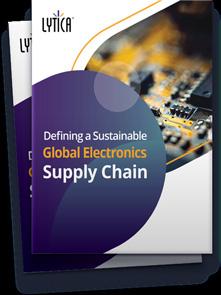
has to identify what IT can serve the business and then follow through with the best possible IT investment decisions.”

To navigate these challenges, digital procurement systems are providing organisations with answers. But as Ian Nethercot, a supply chain director at IT procurement companyProbrand, explains, a study by the company has found that very few organisations are making headway when it comes to digitalisation.
“Research produced by Probrand, in collaboration with CIPS, has revealed that fewer than one in five (18%) believe they have reached a point of full digitalisation,” he says. “Furthermore, 28% say they are yet to make plans to move in this direction.”
According to Paltron, the digitalisation of procurement is often treated as a poor relation – omnipresent areas such as sales, marketing or IT security draw all the attention.
“Although the primary focus on these areas is justified at the beginning, procurement is another crucial component that holds a real treasure for companies: a large set of existing data as well as additional connections to many internal and external departments and areas,” the company says. “In particular, the connection to suppliers and stakeholders as well as the entire supply chain.”

Probrand’s study revealed that most IT buyers feel held back by a lack of digitalisation – with almost two-thirds (63%) still relying on manual systems to complete standard tasks, such as placing orders.
“The results also showed that a quarter are spending the equivalent of one day each week just researching IT purchases – this includes comparing equipment specifications, checking prices and stock availability,” Nethercot adds. “Liaising with suppliers during the ordering process was also revealed as a huge drain on buyers’ time – with 71% saying they spend a significant amount of time emailing and 70% saying the same effort was being spent on calls.”
But these weren’t the only duties taking up a lot of time.
“The vast majority,” Nethercot explains, “said they were also burdened by tasks such
as tracking orders, checking prices and stock, processing orders, and chasing returns and errors. Even straightforward tasks, like raising a PO number, are taking three days or more for most buyers – almost a fifth said this was taking longer than a week.
“Standing still on digitalisation will undoubtedly leave businesses at a competitive disadvantage.


“Failure to digitalise impacts an organisation’s ability to find and keep its best people”
IAN NETHERCOT SUPPLY CHAIN DIRECTOR, PROBRAND
Bogged down by unnecessary admin, a lack of access to live data is leaving buyers struggling to buy at the best times and gain value from every purchase. As a result, they also have less time to spend building strategic relationships with the suppliers that can help them better meet the needs of their organisation,” he comments. “So why are procurement professionals still working in this manual way?”
As part of its study, Probrand asked IT buyers what their biggest obstacles to digitalisation are. Almost two-thirds listed ‘budget’ as a problem, while other issues included dealing with ‘legacy systems’ and ‘winning the support of management’.

“Interestingly,” Nethercot adds, “more than one in ten (12%) listed being ‘unsure how to write a business case for digitalisation’ as a challenge. Given that digital transformation in procurement shouldn’t incur major costs and typically delivers a significant return on investment (ROI), this is an issue that needs addressing.
“What was clear from the research, however, was that there is a desire among
“Fewer than one in five organisations believe they have reached a point of full digitalisation”
IAN NETHERCOT SUPPLY CHAIN DIRECTOR, PROBRAND
TITLE: SUPPLY CHAIN DIRECTOR
COMPANY: PROBRAND
INDUSTRY: IT SERVICES
LOCATION: UNITED KINGDOM

Nethercot has enjoyed a 20-year career, starting as a buyer, and working his way up to supply chain director. He joined Probrand in 2003 and now leads a staff of 15 across supply chain and logistics. He is skilled in strategic procurement, digital transformation, eCommerce, supplier risk assessment and contract management.

63%
Almost two-thirds of IT buyers still rely on manual systems to complete standard procurement tasks
procurement professionals to achieve digitalisation – with 74% saying they are either working on their digital transformation plans, are part way through implementing it or are looking to move in this direction.”

What’s clear is that, given time, digitalisation will become the norm. That must be a concern for those organisations not currently taking steps in this direction.
“When it comes to recruiting and retaining the best procurement talent, a failure to digitalise will impact an organisation’s ability to find and keep the best people,” Nethercot asserts. “This will affect the quality of the workforce and impact long-term business performance.
What’s more, as we continue to experience a period of global uncertainty and sustained periods of supply chain disruption, organisations will need tools in place to manage their suppliers. By empowering procurement teams with the technology and data, organisations can better manage risk by making informed purchasing decisions.
“A failure to digitalise procurement processes will ultimately hurt the overall businesses in several other ways too –
through higher costs, slower deployment of equipment, employee dissatisfaction and a competitive disadvantage.”
As Nethercot describes, it is concerning, therefore, that almost a quarter are still not moving in this direction. Especially when it is possible to do this without heavy investment.
“For example, by working with suppliers that offer live supply chain data, procurement teams can gain ready access to the information they need to make
smart decisions and buy at the best times. By integrating these information streams within their own systems, they can also start to enable digital workflow and approval systems that will allow them to act faster.

“None of the barriers to digitalisation are insurmountable, yet four out of five organisations still say they are yet to fully do so,” Nethercot concludes.
“Those who have a clear vision and are putting plans in place will get there sooner, however – and they will enable their organisation to act more efficiently and effectively in the process.”
“None of the barriers to digitalisation are insurmountable”
IAN NETHERCOT SUPPLY CHAIN DIRECTOR, PROBRAND
Insights from Proxima’s Ashley Clark & Philip Hong on leveraging product durability in procurement for savings, satisfaction & sustainability
WRITTEN BY: ILKHAN OZSEVIMIn business, in the world, and in the realm of procurement, prioritising product durability and longevity brings numerous advantages that resonate with both businesses and the environment. Here’s why it matters:
Longer product lifetimes can lead to cost savings for both consumers and manufacturers.
Consumers can save money by purchasing products that last longer and require less maintenance or replacement.




An award-winning collaborative supplier relationship platform

Suppeco leverages the potential in relationships to solve key challenges within the value chain
A practical solution built for the real world
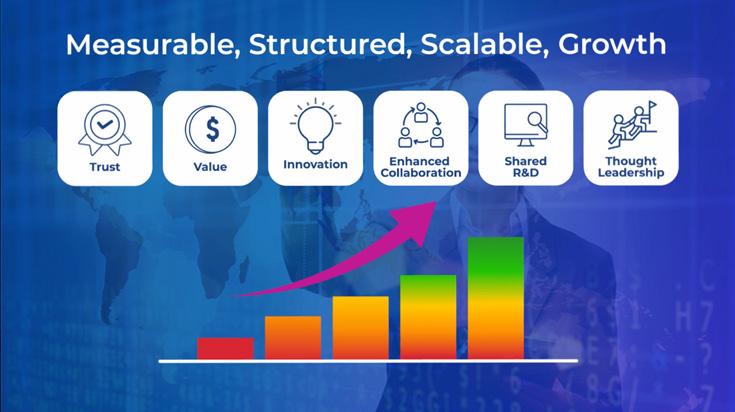
Manufacturers can benefit from increased customer loyalty, reduced warranty claims, and lower production costs.


More and more, consumers want products that are reliable and meet their needs over time. When products fail prematurely, consumers may become frustrated and dissatisfied, which can damage brand reputation and reduce sales.
Extending the lifetime of a product reduces
waste and conserves resources. When products are designed to last longer, they can be reused, repaired, refurbished or remanufactured, which reduces the need for new products and minimises the environmental impact of manufacturing and disposal.
By placing emphasis on product durability and longevity in procurement decisions, professionals can drive positive environmental impact, enhance customer satisfaction, and realise economic benefits.
Ashley Clark and Philip Hong of Proxima, hold that the value that product durability
“A PRODUCT THAT HAS DURABILITY AND LONGEVITY IN MIND FROM THE START NEGATES SCRAP AND WASTE, AS WELL AS REDUCING THE CHANCE THAT THE PRODUCT WILL BE RETURNED”
ASHLEY CLARK VICE PRESIDENT, PROXIMA
and longevity brings to an organisation’s operations vary, based upon the product and business needs; a relative and contextual approach. And they know what they’re talking about.
Clark and Hong are Proxima’s Vice President and Principal Consultant, respectively, and for the few that don’t know, Proxima is a leading global procurement and supply chain consultancy with deep and broad experience under its belt.
Proxima provides expert procurement services to a wide range of clients and everything from assessments through to strategy.
Clark and Hong give us their insights on the subject of product durability and longevity, as well as their importance.
When it comes to product durability and longevity, they feel that it helps to reduce waste and downtime at the plant due to the higher quality of the product, as well as positively impacting brand loyalty by reducing customer frustration with the product.
Incorporating product durability and longevity can also add value to customer
satisfaction, cost efficiency, brand reputation and environmental sustainability; and contributes to long term success in the marketplace.
Ultimately, the purchasing organisation is a company function and should align with the business objectives. If the product is cheap, then purchasing a higher-quality
 Ashley Clark joined Proxima as Principal Consultant before becoming VP in October
Ashley Clark joined Proxima as Principal Consultant before becoming VP in October
A recent YouGov study surveyed consumers in 17 countries, revealing insights into product durability perceptions. Packaged foods and beverages emerged as the most satisfying sector, with 57% of consumers expressing contentment. However, other industries fared relatively
lower. Notably, automobiles, home appliances, and sports equipment garnered reasonably high levels of satisfaction, with automobiles at 50%, appliances at 46%, and sports equipment at 44%. These findings align with the profitability of these industries worldwide.

TITLE: PRINCIPAL CONSULTANT
COMPANY: PROXIMA
INDUSTRY: PROCUREMENT AND SUPPLY CHAIN CONSULTANCY
LOCATION: GREATER CHICAGO, ILLINOIS, UNITED STATES
Joining Proxima as Principal Consultant in June 2022, Philip Hong has previously worked for PepsiCo and The Kraft Heinz Company. He has extensive knowlege of packaging design and engineering solutions.

component is a lost cost for the company, as the customer will not realise the higher value of the product.
Contrastingly, if the product is considered to be high quality and a cheap component is purchased, customers could lose respect for the brand and become frustrated with their purchase.
Clark and Hong agree that designing a product with durability and longevity in mind from the start instantly negates scrap and waste, as well as reducing the chance that the product will be returned. This helps the overall operations function become more sustainable and empowers the end customer to reduce their waste as well.
“Spending time considering the product is not a common aspect of the procurement strategy, as there are often other supply and pricing challenges occurring,” says Clark.
However, being able to adopt this perspective brings a more strategic view to the procurement category. That being said, this is not typically considered common practice due to cost savings being pushed down from finance departments. This could be seen as a misalignment of incentives where procurement is looking at short term savings versus what is best for the brand.
“Setting measurable KPIs, such as including operational waste costs included in procurement’s KPIs, can help organisations incorporate this into their procurement strategies,” says Hong.
“It’s important that procurement teams spend time within other functions
“IT’S IMPORTANT THAT PROCUREMENT TEAMS SPEND TIME WITHIN OTHER FUNCTIONS ACROSS THE BUSINESS TO UNDERSTAND HOW WELL THE PRODUCT IS PERFORMING”
PHILIP HONG PRINCIPAL CONSULTANT, PROXIMA

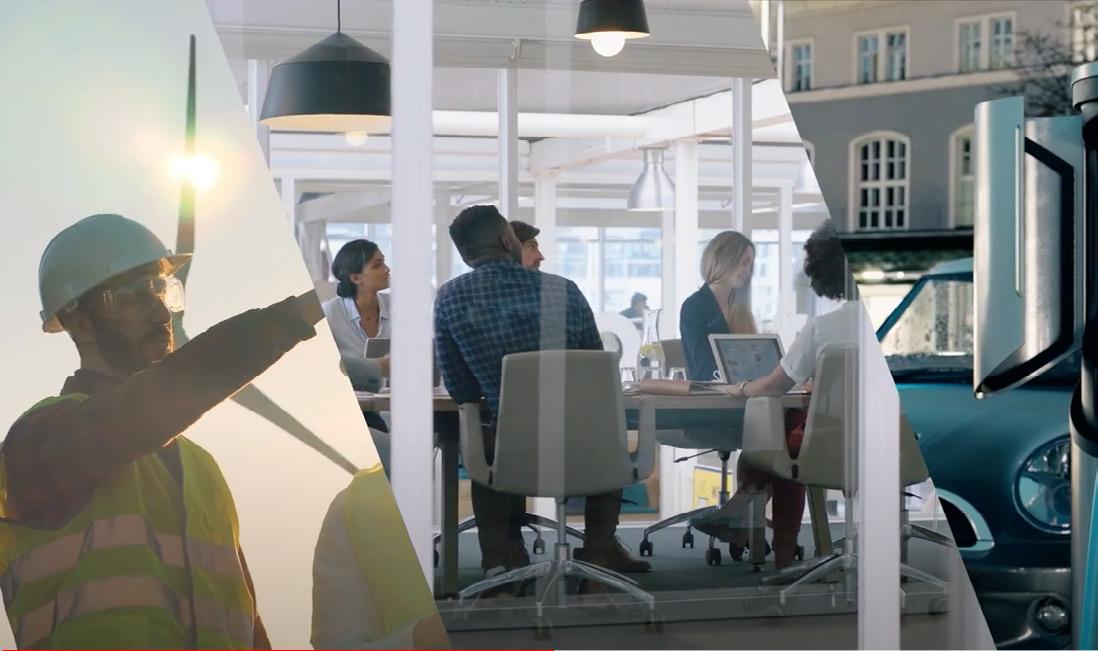
Ashley Clark
TITLE: VICE PRESIDENT
COMPANY: PROXIMA
INDUSTRY: PROCUREMENT AND SUPPLY CHAIN CONSULTANCY

LOCATION: WATERFORD, MICHIGAN, UNITED STATES
Joining Proxima as Principal Consultant in January 2022, Ashley Clark has a long history of working in supply chain, purchasing, sales and marketing, with a particular focus on developing and streamlining business strategies. She has been Proxima’s Vice President since October 2022.
across the business such as sales, business development and engineering, to understand how well the product is performing and whether there are any new strategic or design needs.”
This information can then be fed into developing the procurement strategy to ensure the right supply base is utilised and the correct technical capabilities are in place to support business needs. “Suppliers should
“SPENDING TIME CONSIDERING THE PRODUCT IS NOT A COMMON ASPECT OF THE PROCUREMENT STRATEGY, AS THERE ARE OFTEN OTHER SUPPLY AND PRICING CHALLENGES OCCURRING ”
ASHLEY CLARK VICE PRESIDENT, PROXIMA
also be heavily involved in plans to support these new technologies and designs as this creates the most value for the business and end customer.”
Both Clark and Hong feel that a few technologies exist in this area focusing on measuring metrics at operations and sales.
This could include a more robust ERP system where KPIs can be measured and visible or communicating with peers through a collaboration software.
Though, they say, this ultimately comes down to the product itself, a well thought out design with upstream maintenance and regular reviews of its effectiveness and performance ensures that a product is durable and suitable for the long term.


Procurement Magazine takes a look at 10 of the leading technology players in procurement and how they are innovating with generative AI
WRITTEN BY: GEORGIA WILSON/GLEN WHITEGenerative AI platforms can play a significant role in enhancing various aspects of procurement processes. These platforms leverage artificial intelligence (AI) and machine learning (ML) techniques to generate, analyse, and optimise procurementrelated data, leading to more efficient and effective procurement strategies.

Procurement Magazine takes a look at some of the ways ‘Generative AI platforms’ can be used in procurement:
• Demand forecasting
• Supplier selection
• Price optimisation
• Contract analysis
• Fraud detection
• Supplier relationship management (SRM)
• Market intelligence
It’s worth noting that while Generative AI platforms can offer valuable support in procurement processes, human expertise and judgement remain crucial. The technology should be seen as a tool to augment human decision-making and streamline processes, rather than a substitute for human involvement.
Basware, the go to provider for financial leaders to automate their complex and labour intensive invoice processes to achieve a new level of efficiency.

When it comes to AI and ML, Basware offers many capability benefits across the P2P cycle. From invoice capture and data extraction, to coding and matching, Basware’s innovative AI and ML technologies adds value for procurement and finance professionals to accelerate processing times, reduce the need for manual effort, and eliminate errors.


basware.com
Dedicated to creating solutions that provide the most intelligent, transparent, frictionless commerce in the markets it serves, JAGGAER has been operating in the procurement industry for more than 25 years.
When it comes to procurement contract management, JAGGAER has just the tool. Powered by AI, ML and optical character recognition (OCR) technology, ‘JAGGAER Contracts AI’ can support procurement professional thought the entire journey. The benefits of JAGGAER Contract AI include reduced project cost; risk management and understanding risk and obligations; reduced revenue leakage; and increased speed and efficiency when it comes to contract review and deal velocity.
jaggaer.com

Globality, a leader in autonomous procurement. Using sophisticated AI, enables leading global companies to optimise how they spend their money to improve their profits, advance their purpose, and extend their impact.

In particular ‘Glo’ – Globality’s innovative AI-based technology – is designed for autonomous sourcing, provdiing ‘delightful user experience’, ‘intelligence’, and ‘data driven insights’. With Glo as an AI partner, procurement professionals can be guided through each step of the sourcing journey by precisely scoping requirements, instantly providing best-fit suppliers, giving insights to help assess supplier proposals, and enabling users to make the right decisions.

As a pioneer in Cognitive Procurement software and a trusted partner of choice for large global enterprises, Zycus powers its S2P software with the revolutionary Merlin AI Suite. Merlin AI takes over the tactical tasks for procurement professionals and empowers procurement and AP officers to focus on more strategic projects.
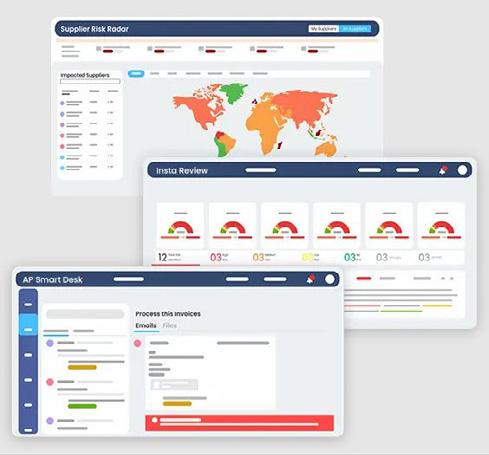
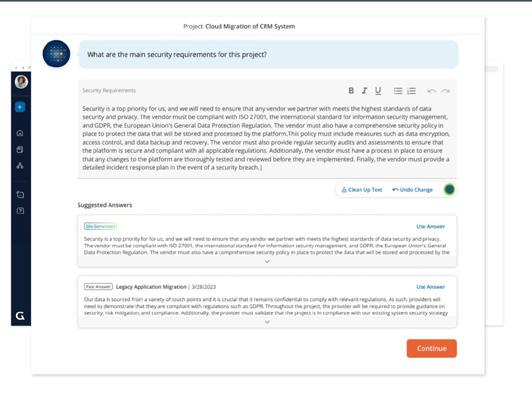
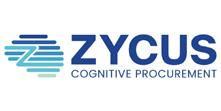
Specifically Merlin AP automation
AI procurement software is a self-learning aterficially intelligent solution with two unique products – AP Smart Desk and Invoice Reader. The two combined offer enhanced productivity, reduced turnaround time, maximised savings, and minimised payment related risks for its users.
zycus.com

Offering procurement professionals with an integrated source-to-settle suite that automates business processes, enables strategic sourcing, improves SRM and simplifies buying.
Key features of Oracle Fusion Cloud Procurement to improve operational efficiency include:
Streamlined shopping and spend management
Manage direct materials, services, and complex procurement
Increase agility with SRM

Deliver greater value through strategic sourcing
Manage supplier contract lifecycle and compliance
Increase business value through analytic insights


Improve supplier collaboration and productivity oracle.com

Believing in revolutionary abilities of digital transformation for supply chain sustainability and resiliency to unlock the power of supplier collaboration, Ivalua is a leading provider of spend management solutions.
The company’s single and unified platform helps customers to efficiently manage all supplier relationships and spend, by providing insightsa to make better and faster decisions, automation to free capacity for strategic objectives, and collaboration tools to effectively engage suppliers.


ivalua.com


A leading provider of innovative procurement and supply chain software. A global supply chain and operations consulting powerhouse. A best-of-breed provider of managed procurement and supply chain services, GEP is all of the above.
GEP’s unified approach to solutions delivery integrating strategy, software and managed services helps their clients achieve strategic, operational and financial objectives. GEP has built a unified framework of integrated sourcing, procurement, spend management and end-to-end supply chain capabilities, supporting their customers’ needs.

GEP.com
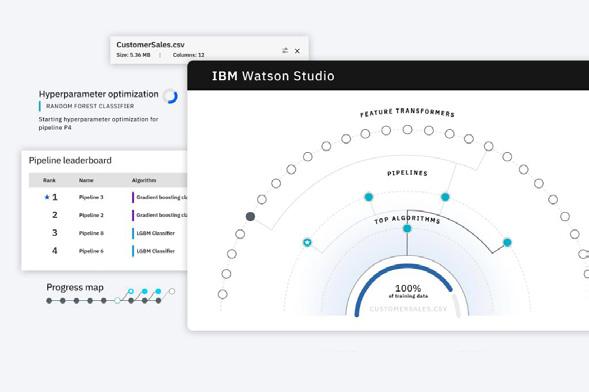

Business priorities are shifting faster than ever. To respond to new customer preferences or new deliverables, you need a flexible workforce. Contingent labour helps, but sourcing and staffing those workers is a full-time job.
With Watson, you can spend less time staffing and more time delivering. By using advanced AI skills, Watson can compile requirements from key stakeholders, and then work within your vendor management system (VMS) to open a request with suppliers to find qualified candidates and schedule interviews with hiring managers. Watson helps you move quickly, so you can meet your client’s skill needs on time.
ibm.com


SAP Ariba is a cloud-based procurement platform and business network developed by SAP, a leading enterprise software company. It provides a range of procurement solutions and services that help organisations manage their procurement processes, collaborate with suppliers, and optimise their supply chains.
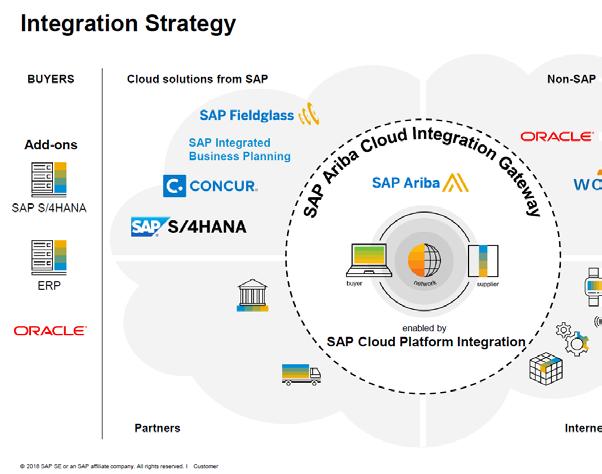
SAP Ariba aims to help organisations improve procurement efficiency, reduce costs, increase transparency, and enhance supplier relationships. It provides a scalable and flexible solution that can be tailored to meet the specific needs of different industries and organisations.
SAP.com







CEO: Charles Goodman Charles Goodman is the Chairman of the Board and interim CEO at Coupa, taking on the role in May 2023. Charles has more than 30 years of experience building successful enterprise software businesses. He joined the Coupa board in February 2023.

Coupa is a cloud-based spend management platform and software company. It provides a comprehensive suite of solutions designed to help organisations streamline and automate their procurement, invoicing, and expense management processes. Coupa’s platform offers functionalities for procurement, expenses, invoicing, sourcing, contract management, supplier management, and analytics, among others. Coupa AI Spend Classification cuts out manual classification drudgery with Machine Learning and Artificial Intelligence to standardise, classify, and enrich spend across spend and ERP systems.


Coupa.com



8 - 9 November 2023
QEII Centre, London
SPONSORSHIPS GET YOUR PASS